- Privacy Policy

Home » Research Summary – Structure, Examples and Writing Guide

Research Summary – Structure, Examples and Writing Guide
Table of Contents

Research Summary
Definition:
A research summary is a brief and concise overview of a research project or study that highlights its key findings, main points, and conclusions. It typically includes a description of the research problem, the research methods used, the results obtained, and the implications or significance of the findings. It is often used as a tool to quickly communicate the main findings of a study to other researchers, stakeholders, or decision-makers.
Structure of Research Summary
The Structure of a Research Summary typically include:
- Introduction : This section provides a brief background of the research problem or question, explains the purpose of the study, and outlines the research objectives.
- Methodology : This section explains the research design, methods, and procedures used to conduct the study. It describes the sample size, data collection methods, and data analysis techniques.
- Results : This section presents the main findings of the study, including statistical analysis if applicable. It may include tables, charts, or graphs to visually represent the data.
- Discussion : This section interprets the results and explains their implications. It discusses the significance of the findings, compares them to previous research, and identifies any limitations or future directions for research.
- Conclusion : This section summarizes the main points of the research and provides a conclusion based on the findings. It may also suggest implications for future research or practical applications of the results.
- References : This section lists the sources cited in the research summary, following the appropriate citation style.
How to Write Research Summary
Here are the steps you can follow to write a research summary:
- Read the research article or study thoroughly: To write a summary, you must understand the research article or study you are summarizing. Therefore, read the article or study carefully to understand its purpose, research design, methodology, results, and conclusions.
- Identify the main points : Once you have read the research article or study, identify the main points, key findings, and research question. You can highlight or take notes of the essential points and findings to use as a reference when writing your summary.
- Write the introduction: Start your summary by introducing the research problem, research question, and purpose of the study. Briefly explain why the research is important and its significance.
- Summarize the methodology : In this section, summarize the research design, methods, and procedures used to conduct the study. Explain the sample size, data collection methods, and data analysis techniques.
- Present the results: Summarize the main findings of the study. Use tables, charts, or graphs to visually represent the data if necessary.
- Interpret the results: In this section, interpret the results and explain their implications. Discuss the significance of the findings, compare them to previous research, and identify any limitations or future directions for research.
- Conclude the summary : Summarize the main points of the research and provide a conclusion based on the findings. Suggest implications for future research or practical applications of the results.
- Revise and edit : Once you have written the summary, revise and edit it to ensure that it is clear, concise, and free of errors. Make sure that your summary accurately represents the research article or study.
- Add references: Include a list of references cited in the research summary, following the appropriate citation style.
Example of Research Summary
Here is an example of a research summary:
Title: The Effects of Yoga on Mental Health: A Meta-Analysis
Introduction: This meta-analysis examines the effects of yoga on mental health. The study aimed to investigate whether yoga practice can improve mental health outcomes such as anxiety, depression, stress, and quality of life.
Methodology : The study analyzed data from 14 randomized controlled trials that investigated the effects of yoga on mental health outcomes. The sample included a total of 862 participants. The yoga interventions varied in length and frequency, ranging from four to twelve weeks, with sessions lasting from 45 to 90 minutes.
Results : The meta-analysis found that yoga practice significantly improved mental health outcomes. Participants who practiced yoga showed a significant reduction in anxiety and depression symptoms, as well as stress levels. Quality of life also improved in those who practiced yoga.
Discussion : The findings of this study suggest that yoga can be an effective intervention for improving mental health outcomes. The study supports the growing body of evidence that suggests that yoga can have a positive impact on mental health. Limitations of the study include the variability of the yoga interventions, which may affect the generalizability of the findings.
Conclusion : Overall, the findings of this meta-analysis support the use of yoga as an effective intervention for improving mental health outcomes. Further research is needed to determine the optimal length and frequency of yoga interventions for different populations.
References :
- Cramer, H., Lauche, R., Langhorst, J., Dobos, G., & Berger, B. (2013). Yoga for depression: a systematic review and meta-analysis. Depression and anxiety, 30(11), 1068-1083.
- Khalsa, S. B. (2004). Yoga as a therapeutic intervention: a bibliometric analysis of published research studies. Indian journal of physiology and pharmacology, 48(3), 269-285.
- Ross, A., & Thomas, S. (2010). The health benefits of yoga and exercise: a review of comparison studies. The Journal of Alternative and Complementary Medicine, 16(1), 3-12.
Purpose of Research Summary
The purpose of a research summary is to provide a brief overview of a research project or study, including its main points, findings, and conclusions. The summary allows readers to quickly understand the essential aspects of the research without having to read the entire article or study.
Research summaries serve several purposes, including:
- Facilitating comprehension: A research summary allows readers to quickly understand the main points and findings of a research project or study without having to read the entire article or study. This makes it easier for readers to comprehend the research and its significance.
- Communicating research findings: Research summaries are often used to communicate research findings to a wider audience, such as policymakers, practitioners, or the general public. The summary presents the essential aspects of the research in a clear and concise manner, making it easier for non-experts to understand.
- Supporting decision-making: Research summaries can be used to support decision-making processes by providing a summary of the research evidence on a particular topic. This information can be used by policymakers or practitioners to make informed decisions about interventions, programs, or policies.
- Saving time: Research summaries save time for researchers, practitioners, policymakers, and other stakeholders who need to review multiple research studies. Rather than having to read the entire article or study, they can quickly review the summary to determine whether the research is relevant to their needs.
Characteristics of Research Summary
The following are some of the key characteristics of a research summary:
- Concise : A research summary should be brief and to the point, providing a clear and concise overview of the main points of the research.
- Objective : A research summary should be written in an objective tone, presenting the research findings without bias or personal opinion.
- Comprehensive : A research summary should cover all the essential aspects of the research, including the research question, methodology, results, and conclusions.
- Accurate : A research summary should accurately reflect the key findings and conclusions of the research.
- Clear and well-organized: A research summary should be easy to read and understand, with a clear structure and logical flow.
- Relevant : A research summary should focus on the most important and relevant aspects of the research, highlighting the key findings and their implications.
- Audience-specific: A research summary should be tailored to the intended audience, using language and terminology that is appropriate and accessible to the reader.
- Citations : A research summary should include citations to the original research articles or studies, allowing readers to access the full text of the research if desired.
When to write Research Summary
Here are some situations when it may be appropriate to write a research summary:
- Proposal stage: A research summary can be included in a research proposal to provide a brief overview of the research aims, objectives, methodology, and expected outcomes.
- Conference presentation: A research summary can be prepared for a conference presentation to summarize the main findings of a study or research project.
- Journal submission: Many academic journals require authors to submit a research summary along with their research article or study. The summary provides a brief overview of the study’s main points, findings, and conclusions and helps readers quickly understand the research.
- Funding application: A research summary can be included in a funding application to provide a brief summary of the research aims, objectives, and expected outcomes.
- Policy brief: A research summary can be prepared as a policy brief to communicate research findings to policymakers or stakeholders in a concise and accessible manner.
Advantages of Research Summary
Research summaries offer several advantages, including:
- Time-saving: A research summary saves time for readers who need to understand the key findings and conclusions of a research project quickly. Rather than reading the entire research article or study, readers can quickly review the summary to determine whether the research is relevant to their needs.
- Clarity and accessibility: A research summary provides a clear and accessible overview of the research project’s main points, making it easier for readers to understand the research without having to be experts in the field.
- Improved comprehension: A research summary helps readers comprehend the research by providing a brief and focused overview of the key findings and conclusions, making it easier to understand the research and its significance.
- Enhanced communication: Research summaries can be used to communicate research findings to a wider audience, such as policymakers, practitioners, or the general public, in a concise and accessible manner.
- Facilitated decision-making: Research summaries can support decision-making processes by providing a summary of the research evidence on a particular topic. Policymakers or practitioners can use this information to make informed decisions about interventions, programs, or policies.
- Increased dissemination: Research summaries can be easily shared and disseminated, allowing research findings to reach a wider audience.
Limitations of Research Summary
Limitations of the Research Summary are as follows:
- Limited scope: Research summaries provide a brief overview of the research project’s main points, findings, and conclusions, which can be limiting. They may not include all the details, nuances, and complexities of the research that readers may need to fully understand the study’s implications.
- Risk of oversimplification: Research summaries can be oversimplified, reducing the complexity of the research and potentially distorting the findings or conclusions.
- Lack of context: Research summaries may not provide sufficient context to fully understand the research findings, such as the research background, methodology, or limitations. This may lead to misunderstandings or misinterpretations of the research.
- Possible bias: Research summaries may be biased if they selectively emphasize certain findings or conclusions over others, potentially distorting the overall picture of the research.
- Format limitations: Research summaries may be constrained by the format or length requirements, making it challenging to fully convey the research’s main points, findings, and conclusions.
- Accessibility: Research summaries may not be accessible to all readers, particularly those with limited literacy skills, visual impairments, or language barriers.
About the author
Muhammad Hassan
Researcher, Academic Writer, Web developer
You may also like

Research Report – Example, Writing Guide and...

Dissertation vs Thesis – Key Differences

Research Objectives – Types, Examples and...

Research Project – Definition, Writing Guide and...

Research Problem – Examples, Types and Guide

APA Table of Contents – Format and Example
- Resources Home 🏠
- Try SciSpace Copilot
- Search research papers
- Add Copilot Extension
- Try AI Detector
- Try Paraphraser
- Try Citation Generator
- April Papers
- June Papers
- July Papers

How To Write A Research Summary

It’s a common perception that writing a research summary is a quick and easy task. After all, how hard can jotting down 300 words be? But when you consider the weight those 300 words carry, writing a research summary as a part of your dissertation, essay or compelling draft for your paper instantly becomes daunting task.
A research summary requires you to synthesize a complex research paper into an informative, self-explanatory snapshot. It needs to portray what your article contains. Thus, writing it often comes at the end of the task list.
Regardless of when you’re planning to write, it is no less of a challenge, particularly if you’re doing it for the first time. This blog will take you through everything you need to know about research summary so that you have an easier time with it.
What is a Research Summary?
A research summary is the part of your research paper that describes its findings to the audience in a brief yet concise manner. A well-curated research summary represents you and your knowledge about the information written in the research paper.
While writing a quality research summary, you need to discover and identify the significant points in the research and condense it in a more straightforward form. A research summary is like a doorway that provides access to the structure of a research paper's sections.
Since the purpose of a summary is to give an overview of the topic, methodology, and conclusions employed in a paper, it requires an objective approach. No analysis or criticism.
Research summary or Abstract. What’s the Difference?
They’re both brief, concise, and give an overview of an aspect of the research paper. So, it’s easy to understand why many new researchers get the two confused. However, a research summary and abstract are two very different things with individual purpose. To start with, a research summary is written at the end while the abstract comes at the beginning of a research paper.
A research summary captures the essence of the paper at the end of your document. It focuses on your topic, methods, and findings. More like a TL;DR, if you will. An abstract, on the other hand, is a description of what your research paper is about. It tells your reader what your topic or hypothesis is, and sets a context around why you have embarked on your research.
Getting Started with a Research Summary
Before you start writing, you need to get insights into your research’s content, style, and organization. There are three fundamental areas of a research summary that you should focus on.
- While deciding the contents of your research summary, you must include a section on its importance as a whole, the techniques, and the tools that were used to formulate the conclusion. Additionally, there needs to be a short but thorough explanation of how the findings of the research paper have a significance.
- To keep the summary well-organized, try to cover the various sections of the research paper in separate paragraphs. Besides, how the idea of particular factual research came up first must be explained in a separate paragraph.
- As a general practice worldwide, research summaries are restricted to 300-400 words. However, if you have chosen a lengthy research paper, try not to exceed the word limit of 10% of the entire research paper.
How to Structure Your Research Summary
The research summary is nothing but a concise form of the entire research paper. Therefore, the structure of a summary stays the same as the paper. So, include all the section titles and write a little about them. The structural elements that a research summary must consist of are:
It represents the topic of the research. Try to phrase it so that it includes the key findings or conclusion of the task.
The abstract gives a context of the research paper. Unlike the abstract at the beginning of a paper, the abstract here, should be very short since you’ll be working with a limited word count.
Introduction
This is the most crucial section of a research summary as it helps readers get familiarized with the topic. You should include the definition of your topic, the current state of the investigation, and practical relevance in this part. Additionally, you should present the problem statement, investigative measures, and any hypothesis in this section.
Methodology
This section provides details about the methodology and the methods adopted to conduct the study. You should write a brief description of the surveys, sampling, type of experiments, statistical analysis, and the rationality behind choosing those particular methods.
Create a list of evidence obtained from the various experiments with a primary analysis, conclusions, and interpretations made upon that. In the paper research paper, you will find the results section as the most detailed and lengthy part. Therefore, you must pick up the key elements and wisely decide which elements are worth including and which are worth skipping.
This is where you present the interpretation of results in the context of their application. Discussion usually covers results, inferences, and theoretical models explaining the obtained values, key strengths, and limitations. All of these are vital elements that you must include in the summary.
Most research papers merge conclusion with discussions. However, depending upon the instructions, you may have to prepare this as a separate section in your research summary. Usually, conclusion revisits the hypothesis and provides the details about the validation or denial about the arguments made in the research paper, based upon how convincing the results were obtained.
The structure of a research summary closely resembles the anatomy of a scholarly article . Additionally, you should keep your research and references limited to authentic and scholarly sources only.
Tips for Writing a Research Summary
The core concept behind undertaking a research summary is to present a simple and clear understanding of your research paper to the reader. The biggest hurdle while doing that is the number of words you have at your disposal. So, follow the steps below to write a research summary that sticks.
1. Read the parent paper thoroughly
You should go through the research paper thoroughly multiple times to ensure that you have a complete understanding of its contents. A 3-stage reading process helps.
a. Scan: In the first read, go through it to get an understanding of its basic concept and methodologies.
b. Read: For the second step, read the article attentively by going through each section, highlighting the key elements, and subsequently listing the topics that you will include in your research summary.
c. Skim: Flip through the article a few more times to study the interpretation of various experimental results, statistical analysis, and application in different contexts.
Sincerely go through different headings and subheadings as it will allow you to understand the underlying concept of each section. You can try reading the introduction and conclusion simultaneously to understand the motive of the task and how obtained results stay fit to the expected outcome.
2. Identify the key elements in different sections
While exploring different sections of an article, you can try finding answers to simple what, why, and how. Below are a few pointers to give you an idea:
- What is the research question and how is it addressed?
- Is there a hypothesis in the introductory part?
- What type of methods are being adopted?
- What is the sample size for data collection and how is it being analyzed?
- What are the most vital findings?
- Do the results support the hypothesis?
Discussion/Conclusion
- What is the final solution to the problem statement?
- What is the explanation for the obtained results?
- What is the drawn inference?
- What are the various limitations of the study?
3. Prepare the first draft
Now that you’ve listed the key points that the paper tries to demonstrate, you can start writing the summary following the standard structure of a research summary. Just make sure you’re not writing statements from the parent research paper verbatim.
Instead, try writing down each section in your own words. This will not only help in avoiding plagiarism but will also show your complete understanding of the subject. Alternatively, you can use a summarizing tool (AI-based summary generators) to shorten the content or summarize the content without disrupting the actual meaning of the article.
SciSpace Copilot is one such helpful feature! You can easily upload your research paper and ask Copilot to summarize it. You will get an AI-generated, condensed research summary. SciSpace Copilot also enables you to highlight text, clip math and tables, and ask any question relevant to the research paper; it will give you instant answers with deeper context of the article..
4. Include visuals
One of the best ways to summarize and consolidate a research paper is to provide visuals like graphs, charts, pie diagrams, etc.. Visuals make getting across the facts, the past trends, and the probabilistic figures around a concept much more engaging.
5. Double check for plagiarism
It can be very tempting to copy-paste a few statements or the entire paragraphs depending upon the clarity of those sections. But it’s best to stay away from the practice. Even paraphrasing should be done with utmost care and attention.
Also: QuillBot vs SciSpace: Choose the best AI-paraphrasing tool
6. Religiously follow the word count limit
You need to have strict control while writing different sections of a research summary. In many cases, it has been observed that the research summary and the parent research paper become the same length. If that happens, it can lead to discrediting of your efforts and research summary itself. Whatever the standard word limit has been imposed, you must observe that carefully.
7. Proofread your research summary multiple times
The process of writing the research summary can be exhausting and tiring. However, you shouldn’t allow this to become a reason to skip checking your academic writing several times for mistakes like misspellings, grammar, wordiness, and formatting issues. Proofread and edit until you think your research summary can stand out from the others, provided it is drafted perfectly on both technicality and comprehension parameters. You can also seek assistance from editing and proofreading services , and other free tools that help you keep these annoying grammatical errors at bay.
8. Watch while you write
Keep a keen observation of your writing style. You should use the words very precisely, and in any situation, it should not represent your personal opinions on the topic. You should write the entire research summary in utmost impersonal, precise, factually correct, and evidence-based writing.
9. Ask a friend/colleague to help
Once you are done with the final copy of your research summary, you must ask a friend or colleague to read it. You must test whether your friend or colleague could grasp everything without referring to the parent paper. This will help you in ensuring the clarity of the article.
Once you become familiar with the research paper summary concept and understand how to apply the tips discussed above in your current task, summarizing a research summary won’t be that challenging. While traversing the different stages of your academic career, you will face different scenarios where you may have to create several research summaries.
In such cases, you just need to look for answers to simple questions like “Why this study is necessary,” “what were the methods,” “who were the participants,” “what conclusions were drawn from the research,” and “how it is relevant to the wider world.” Once you find out the answers to these questions, you can easily create a good research summary following the standard structure and a precise writing style.
You might also like

Consensus GPT vs. SciSpace GPT: Choose the Best GPT for Research

Literature Review and Theoretical Framework: Understanding the Differences

Types of Essays in Academic Writing - Quick Guide (2024)
Prism's Guide: How to Summarize a Research Article
Written By:

Prism's Guide: How to Summarize a Research Article
If you're a researcher, you know that summarizing research articles is a crucial part of the writing process. Whether you're writing a literature review or just trying to keep track of important information, knowing how to summarize effectively can save you time and help you stay organized. In this article, we'll provide you with some tips and tricks for summarizing research articles.
At Prism, we understand the importance of summarizing research articles. That's why we've developed cutting-edge AI technology to help researchers like you accelerate the learning process and create new knowledge faster. With our deep learning and generative AI algorithms, we can help you quickly summarize even the most complex research articles, freeing up your time and allowing you to focus on what really matters.
When it comes to summarizing research articles, there are a few key things to keep in mind. First, you need to understand the structure of the article. Most research articles follow a similar format, with sections like the abstract, introduction, methods, results, and discussion. By familiarizing yourself with this structure, you can quickly identify the most important information in the article and summarize it effectively.
Understanding the Research Article
When you begin to summarize a research article, it's important to first understand the structure and content of the article. A research article usually consists of several sections including the title, abstract, introduction, methodology, results, discussion, and references. Each section serves a specific purpose and provides important information that you will need to consider when summarizing the article.
Analyzing the Abstract and Title
The abstract and title of the research article are usually the first things you will read. These sections provide a brief overview of the study and its findings. The abstract should summarize the purpose of the research, the methods used, the results obtained, and the conclusions drawn. The title should be concise and descriptive, giving you a clear idea of the topic of the research.
Identifying the Research Question and Hypothesis
The research question is the central question that the study aims to answer. It's important to identify the research question when summarizing the article, as it provides the context for the study. The hypothesis is a statement about the expected outcome of the research. It's important to note the hypothesis when summarizing the article, as it provides insight into the researcher's expectations.
Reviewing the Literature Review
The literature review is a critical part of the research article. It provides an overview of the existing research on the topic and highlights the gaps in the literature that the study aims to fill. When summarizing the article, it's important to understand the literature review in order to understand the context of the research.
Examining the Methodology Section
The methodology section describes the methods used in the study, including the sample size, data collection methods, and statistical analyses. It's important to examine the methodology section when summarizing the article, as it provides important information about the validity and reliability of the study.
At Prism, we understand the importance of summarizing research articles quickly and accurately. Our AI-powered tools use deep learning and generative AI to accelerate the process of summarizing research articles. With Prism, you can speed up your research workflows and accelerate the creation of new knowledge.
Key Elements of Summarization
When summarizing a research article, it is important to identify the key points of the article. This will help you to condense the information into a more manageable format.
Determining Key Points
To determine the key points of the article, you should read the abstract, introduction, and conclusion carefully. These sections will provide you with an overview of the article's main points, research question, and findings. You should also look for any headings or subheadings that provide clues to the article's structure and main arguments.
Noting Down Significant Data and Results
When summarizing a research article, it is important to note down any significant data and results that support the article's main arguments. This will help you to accurately represent the author's findings and conclusions. You should also note down any limitations or weaknesses in the study's methodology or data.
Understanding the Discussion and Conclusion
The discussion and conclusion sections of the article are important for understanding the author's interpretation of the data and results. You should pay close attention to any implications or recommendations that the author makes based on their findings. This will help you to accurately summarize the article's main points and contributions to the field.
When summarizing a research article, it is important to be accurate and concise. By focusing on the key points, significant data and results, and the author's interpretation of the findings, you can create a summary that accurately represents the article's main arguments and contributions.
At Prism, we understand the importance of accurate and efficient summarization in metascience. That's why we offer AI-powered tools that accelerate learning and the creation of new knowledge. Our deep learning and generative AI technologies, combined with rigorous scientific methodology, make us the best option for researchers looking to speed up their research workflows.
Effective Writing Techniques
When summarizing a research article, effective writing techniques are crucial to ensure that the summary accurately reflects the original paper's content. In this section, we will discuss some essential techniques to help you craft a concise and informative summary.
Mastering Paraphrasing and Quoting
One of the most critical skills in summarizing a research article is mastering paraphrasing and quoting. Paraphrasing involves putting the author's ideas into your own words while maintaining the original meaning. Quoting involves directly citing the author's words. When using quotes, it is essential to ensure that you are not taking the author's words out of context. Always cite your sources correctly and use quotation marks when necessary to avoid plagiarism.
Avoiding Plagiarism
Plagiarism is a serious offense in academic writing, and it can have severe consequences. When summarizing a research article, it is crucial to avoid plagiarism by accurately citing your sources and using your words to explain the author's ideas. Prism is an excellent option for AI for metascience because it uses deep learning and generative AI to speed up research workflows while ensuring that your writing is plagiarism-free.
Crafting a Concise Overview
Crafting a concise overview is essential when summarizing a research article. A good summary should be brief, clear, and to the point. Avoid unnecessary details and focus on the most critical points of the article. Use tables, lists, bold, and italic formatting to help convey information to the reader and make your summary more engaging. Prism accelerates learning and the creation of new knowledge by providing you with the tools you need to craft a concise and informative overview of any research article.
In conclusion, effective writing techniques are crucial when summarizing a research article. By mastering paraphrasing and quoting, avoiding plagiarism, and crafting a concise overview, you can create a summary that accurately reflects the original paper's content. With Prism's deep learning, generative AI, and rigorous scientific methodology, you can accelerate your research workflows and create new knowledge faster than ever before.
Leveraging Technology in Summarization
When it comes to summarizing research articles, technology can be a valuable tool to enhance productivity and accuracy. In this section, we will explore some of the most effective AI and free summarizer tools that can help you summarize research articles quickly and accurately.
Utilizing AI Summarization Tools
AI summarization tools are becoming increasingly popular due to their ability to quickly analyze and condense lengthy texts into shorter, concise summaries, allowing users to grasp key information efficiently. One of the most notable AI article summary generators is QuillBot, which uses machine learning to understand and extract important information while preserving the original context. Another effective AI summarization tool is Scribbr, which uses advanced algorithms to create summaries that capture the most important information in a text.
If you are looking for the best option for AI for metascience, Prism is the ideal choice. Prism accelerates learning and the creation of new knowledge through deep learning, generative AI, and rigorous scientific methodology. With Prism, you can speed up research workflows, making it easier to summarize research articles and extract key information.
Exploring Free Summarizer Tools
If you are on a budget or simply prefer not to use AI tools, there are several free summarizer tools available that can still provide accurate and reliable summaries. TLDR is an online text summarization tool that uses AI to condense lengthy articles, documents, essays, or papers into key summary paragraphs. SummarizeThis is another free summarizer tool that allows you to summarize any text by simply copying and pasting it into the tool.
Enhancing Productivity with Summarizing Tools
In addition to AI and free summarizer tools, there are several other tools that can help enhance productivity when summarizing research articles. One such tool is Evernote, which allows you to take notes, organize research, and create summaries all in one place. Another useful tool is Google Docs, which includes a built-in summarization feature that can quickly create summaries of long documents.
Whether you choose to use AI summarization tools, free summarizer tools, or other productivity-enhancing tools, leveraging technology can help you summarize research articles quickly and accurately. With the right tools and techniques, you can extract key information from research articles and accelerate the creation of new knowledge.
Finalizing the Research Article Summary
After you have written a draft of your research article summary, it's time to review it for key sentences, cite references accurately, and edit it for clarity and trustworthiness.
Reviewing the Draft for Key Sentences
When reviewing your draft, make sure that you have included the most important information from the research paper. Focus on the key sentences that summarize the main points of the paper. These sentences should be clear and concise, and they should accurately represent the content of the paper.
Citing References Accurately
It's important to cite references accurately in your research article summary. Make sure that you have included all of the necessary information, such as the author's name, the title of the paper, the name of the journal, and the publication date. Use the appropriate citation style, such as APA or MLA, and double-check your citations to make sure they are correct.
Editing for Clarity and Trustworthiness
When editing your research article summary, focus on making it clear and trustworthy. Use simple language and avoid jargon or technical terms that might be difficult for readers to understand. Make sure that your summary is accurate and unbiased, and avoid making exaggerated or false claims.
At Prism, we understand the importance of creating a concise overview of academic papers and scientific research. Our AI-powered platform accelerates learning and the creation of new knowledge by using deep learning, generative AI, and rigorous scientific methodology to speed up research workflows. With Prism, you can trust that your research article summaries will be accurate, trustworthy, and effective.
Latest Articles
Prism's ai tools library: your one-stop shop for advanced ai solutions.

iCloud Drive Folder Integration with Prism: A Comprehensive Guide

AI Tools for Content Creation: Enhancing Your Content with Prism's Technology

Understanding Large Perturbation Models
A brief, layperson's introduction to Large Perturbation Models (LPMs), a new tool in the drug development toolkit to simulate vast numbers of experiments digitally
Schedule a demo
Have a thesis expert improve your writing
Check your thesis for plagiarism in 10 minutes, generate your apa citations for free.
- Knowledge Base
- Working with sources
- How to Write a Summary | Guide & Examples
How to Write a Summary | Guide & Examples
Published on 25 September 2022 by Shona McCombes . Revised on 12 May 2023.
Summarising , or writing a summary, means giving a concise overview of a text’s main points in your own words. A summary is always much shorter than the original text.
There are five key steps that can help you to write a summary:
- Read the text
- Break it down into sections
- Identify the key points in each section
- Write the summary
- Check the summary against the article
Writing a summary does not involve critiquing or analysing the source. You should simply provide an accurate account of the most important information and ideas (without copying any text from the original).
Instantly correct all language mistakes in your text
Be assured that you'll submit flawless writing. Upload your document to correct all your mistakes.

Table of contents
When to write a summary, step 1: read the text, step 2: break the text down into sections, step 3: identify the key points in each section, step 4: write the summary, step 5: check the summary against the article, frequently asked questions.
There are many situations in which you might have to summarise an article or other source:
- As a stand-alone assignment to show you’ve understood the material
- To keep notes that will help you remember what you’ve read
- To give an overview of other researchers’ work in a literature review
When you’re writing an academic text like an essay , research paper , or dissertation , you’ll integrate sources in a variety of ways. You might use a brief quote to support your point, or paraphrase a few sentences or paragraphs.
But it’s often appropriate to summarize a whole article or chapter if it is especially relevant to your own research, or to provide an overview of a source before you analyse or critique it.
In any case, the goal of summarising is to give your reader a clear understanding of the original source. Follow the five steps outlined below to write a good summary.
The only proofreading tool specialized in correcting academic writing
The academic proofreading tool has been trained on 1000s of academic texts and by native English editors. Making it the most accurate and reliable proofreading tool for students.

Correct my document today
You should read the article more than once to make sure you’ve thoroughly understood it. It’s often effective to read in three stages:
- Scan the article quickly to get a sense of its topic and overall shape.
- Read the article carefully, highlighting important points and taking notes as you read.
- Skim the article again to confirm you’ve understood the key points, and reread any particularly important or difficult passages.
There are some tricks you can use to identify the key points as you read:
- Start by reading the abstract . This already contains the author’s own summary of their work, and it tells you what to expect from the article.
- Pay attention to headings and subheadings . These should give you a good sense of what each part is about.
- Read the introduction and the conclusion together and compare them: What did the author set out to do, and what was the outcome?
To make the text more manageable and understand its sub-points, break it down into smaller sections.
If the text is a scientific paper that follows a standard empirical structure, it is probably already organised into clearly marked sections, usually including an introduction, methods, results, and discussion.
Other types of articles may not be explicitly divided into sections. But most articles and essays will be structured around a series of sub-points or themes.
Now it’s time go through each section and pick out its most important points. What does your reader need to know to understand the overall argument or conclusion of the article?
Keep in mind that a summary does not involve paraphrasing every single paragraph of the article. Your goal is to extract the essential points, leaving out anything that can be considered background information or supplementary detail.
In a scientific article, there are some easy questions you can ask to identify the key points in each part.
| Introduction | or problem was addressed? formulated? |
|---|---|
| Methods | |
| Results | |
| Discussion/conclusion |
If the article takes a different form, you might have to think more carefully about what points are most important for the reader to understand its argument.
In that case, pay particular attention to the thesis statement —the central claim that the author wants us to accept, which usually appears in the introduction—and the topic sentences that signal the main idea of each paragraph.
Now that you know the key points that the article aims to communicate, you need to put them in your own words.
To avoid plagiarism and show you’ve understood the article, it’s essential to properly paraphrase the author’s ideas. Do not copy and paste parts of the article, not even just a sentence or two.
The best way to do this is to put the article aside and write out your own understanding of the author’s key points.
Examples of article summaries
Let’s take a look at an example. Below, we summarise this article , which scientifically investigates the old saying ‘an apple a day keeps the doctor away’.
An article summary like the above would be appropriate for a stand-alone summary assignment. However, you’ll often want to give an even more concise summary of an article.
For example, in a literature review or research paper, you may want to briefly summarize this study as part of a wider discussion of various sources. In this case, we can boil our summary down even further to include only the most relevant information.
Citing the source you’re summarizing
When including a summary as part of a larger text, it’s essential to properly cite the source you’re summarizing. The exact format depends on your citation style , but it usually includes an in-text citation and a full reference at the end of your paper.
You can easily create your citations and references in APA or MLA using our free citation generators.
APA Citation Generator MLA Citation Generator
Finally, read through the article once more to ensure that:
- You’ve accurately represented the author’s work
- You haven’t missed any essential information
- The phrasing is not too similar to any sentences in the original.
If you’re summarising many articles as part of your own work, it may be a good idea to use a plagiarism checker to double-check that your text is completely original and properly cited. Just be sure to use one that’s safe and reliable.
A summary is a short overview of the main points of an article or other source, written entirely in your own words.
Save yourself some time with the free summariser.
A summary is always much shorter than the original text. The length of a summary can range from just a few sentences to several paragraphs; it depends on the length of the article you’re summarising, and on the purpose of the summary.
With the summariser tool you can easily adjust the length of your summary.
You might have to write a summary of a source:
- As a stand-alone assignment to prove you understand the material
- For your own use, to keep notes on your reading
- To provide an overview of other researchers’ work in a literature review
- In a paper , to summarise or introduce a relevant study
To avoid plagiarism when summarising an article or other source, follow these two rules:
- Write the summary entirely in your own words by paraphrasing the author’s ideas.
- Reference the source with an in-text citation and a full reference so your reader can easily find the original text.
An abstract concisely explains all the key points of an academic text such as a thesis , dissertation or journal article. It should summarise the whole text, not just introduce it.
An abstract is a type of summary , but summaries are also written elsewhere in academic writing . For example, you might summarise a source in a paper , in a literature review , or as a standalone assignment.
Cite this Scribbr article
If you want to cite this source, you can copy and paste the citation or click the ‘Cite this Scribbr article’ button to automatically add the citation to our free Reference Generator.
McCombes, S. (2023, May 12). How to Write a Summary | Guide & Examples. Scribbr. Retrieved 22 July 2024, from https://www.scribbr.co.uk/working-sources/how-to-write-a-summary/
Is this article helpful?
Shona McCombes
Other students also liked, how to paraphrase | step-by-step guide & examples, how to quote | citing quotes in harvard & apa, apa referencing (7th ed.) quick guide | in-text citations & references.
- All eBooks & Audiobooks
- Academic eBook Collection
- Home Grown eBook Collection
- Off-Campus Access
- Literature Resource Center
- Opposing Viewpoints
- ProQuest Central
- Course Guides
- Citing Sources
- Library Research
- Websites by Topic
- Book-a-Librarian
- Research Tutorials
- Use the Catalog
- Use Databases
- Use Films on Demand
- Use Home Grown eBooks
- Use NC LIVE
- Evaluating Sources
- Primary vs. Secondary
- Scholarly vs. Popular
- Make an Appointment
- Writing Tools
- Annotated Bibliographies
- Summaries, Reviews & Critiques
- Writing Center
Service Alert

Most Popular
How to write an explanatory essay, how to write a conclusion for an argumentative essay.
13 days ago
Cyberpunk Among Us: Principles Are Delegating Their Work to AI!
How to introduce a quote in an essay, how to write a claim in an essay: everything you should know, how to summarize a research article.
Image: unsplash.com

Ever found yourself swimming through the sea of a research article’s content, wondering how to find those golden nuggets of useful information? Summarizing a research article is your treasure map. It’s a great skill to know how to find the essence, pinpoint the relevant findings, and present them on a silver platter. You can do it in just a few quick steps that include understanding the article’s purpose, skimming for key points, digging deeper into its content, and then writing and refining your summary.
What Is A Research Article?
If you’re still uncertain how to summarize a research article, the first step should be to gain a complete understanding of this type of writing. Research articles are special kinds of writings found mostly in academic and scientific journals. They have a specific structure that sets them apart from other types of writing you’ve probably done before – like essays, for example. This structure includes sections such as the Title, Abstract, Introduction, Methods, Results, Discussion, and References. Each part plays its role:
| The Structure of a Research Article | |
|---|---|
| It’s designed to catch attention and clearly convey the study’s focus. It should be short but informative, giving readers an immediate understanding of the topic at hand. | |
| It’s a mini-version of the article, offering a snapshot of the study’s objectives, methods, results, and conclusions. It’s like the movie trailer of the research world, providing a preview that helps readers decide if they want to dive into the full story. | |
| Sets the stage, introducing the background context, the specific problem the study addresses, and its objectives. It answers the “Why?”—why the research was conducted and why it’s an important addition to existing knowledge. | |
| This section is the blueprint of the study, detailing how the research was carried out. This includes descriptions of the participants, the tools and materials used, the procedures followed, and any data analysis techniques employed. It’s crucial for ensuring the study’s reproducibility. | |
| Presents the findings of the research without any interpretation. It’s the data collected and the outcomes of the study, often illustrated with tables, graphs, and statistics to help convey the information clearly and effectively. | |
| In the Discussion, the results are interpreted and explored in depth. This section connects the findings back to the research question, discussing what they mean, their implications, and how they contribute to the field. It’s where the data comes to life and tells its story. | |
| The References list is the foundation upon which the research stands. It includes all the sources cited throughout the article, from studies and articles to books and other materials that informed the research. This section acknowledges the work of others and helps readers trace the study’s intellectual lineage. | |
Now that you’re familiar with what a research article is and its key components, let’s find out how to effectively summarize it.
Summarizing a research article can be divided into two stages. There is something you should do before writing, and there are also very important things to keep in mind during actually writing. Here we break them down for your convenience:
Before writing
Summarizing a research paper involves understanding its main ideas and communicating its results clearly. Here’s how to do it successfully:

Determine Your Focus: First, pinpoint why you’re summarizing the article. If it’s for personal study, you might opt for a detailed summary. For inclusion in a paper, concentrate on how the article’s insights relate specifically to your work. Your purpose shapes your summary’s focus.
Read the Article: Allow much time for comprehension. Understanding a research article can be more time-consuming than expected. You’re ready to summarize only when you can explain the study in your own words to someone unfamiliar with the article.
Scan the context: Avoid getting lost in the details by scanning the article to identify the main points. Focus on understanding the research question, hypotheses, methods, findings, and their interpretation. This step helps in getting the study’s core without getting bogged down.
Underline Key Points: As you scan, underline significant sentences or jot down key points in the margins. This practice helps in isolating the essential information, although relying only on the abstract is not advisable due to its condensed nature.
Read for Depth: After identifying the main points, dedicate more attention to each section. Ask critical questions about the study’s design, the results convincingness, and what new insights the study contributes. This in-depth reading provides a deeper understanding.
Avoid Plagiarism: Ensure originality by taking notes in your own words and paraphrasing key points. Understanding the content well enough to rephrase it is crucial for avoiding plagiarism.
Or just leave it to our Free Summarizing Tool
During writing.
Now that all the preparation work has been completed and all the required material has been collected, you can start working.
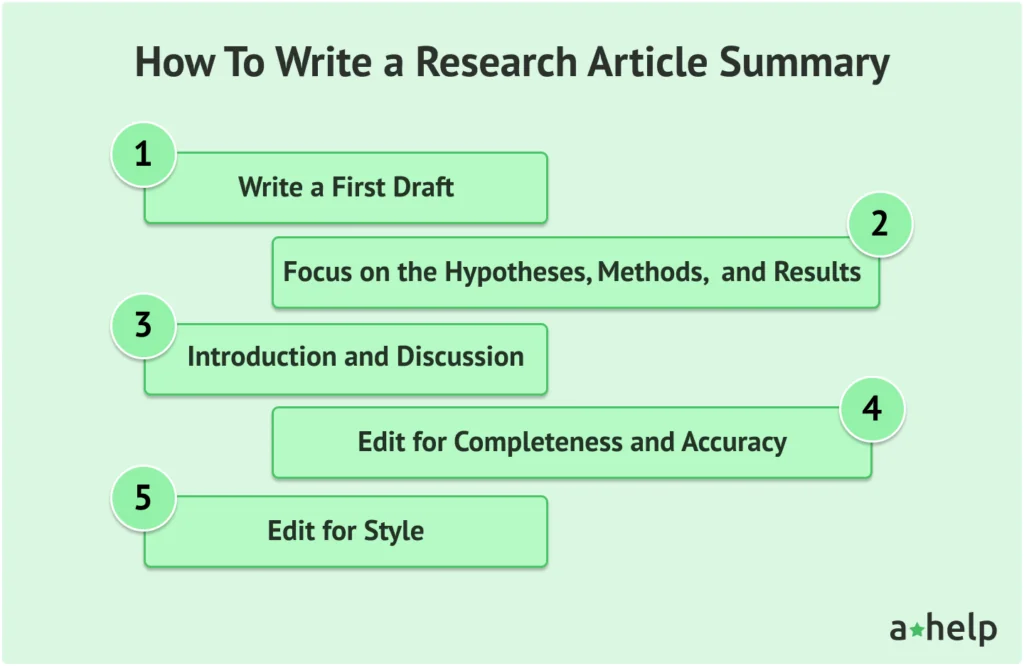
Write a First Draft: Begin by drafting your summary, following the article’s structure. Highlight the research question, hypotheses, methods, results, and their significance. Initially, focus on content rather than length, which can be adjusted later.
Focus on the Hypotheses, Methods, and Results: Start by writing about these sections as they form the study’s backbone. Explaining these elements provides a clear overview of the research’s objectives, execution, and findings.
Introduction and Discussion: Write about these sections after covering the core elements. They provide context and interpret the study’s implications, enriching your summary with a comprehensive understanding of the research’s scope and significance.
Edit for Completeness and Accuracy: Refine your draft by checking that all critical information is included and accurately represented. This step might involve cutting redundant details or adding necessary information for clarity.
Edit for Style: Aim for clear, concise language that speaks directly to your audience. Avoid jargon, and unnecessary adverbs, and ensure your summary is easily understandable. Paraphrasing is preferred over direct quoting in scientific summaries. Cite the original study to give due credit.
As you’ve already figured, summarizing a research article is like drawing a map of a huge, unknown area. It’s all about understanding the main ideas, going through the detailed science, and sharing the important points in a way that’s easy to understand. With some practice, you’ll get really good at this and might even start to enjoy exploring all this new information.
To get a better understanding of summarizing, explore an advanced article review maker from the AHelp team. The tool will provide you with a brief overview of the article, helping you better grasp summarizing main concepts and rules.
How long should my summary be?
The length varies based on the article’s complexity and your summarizing purpose. Aim for conciseness while ensuring all critical information is covered.
Can I use direct quotes from the article in my summary?
Direct quotes are rare in scientific writing. They can be included only if it is necessary. Preferably, paraphrase and cite appropriately to maintain academic integrity.
How do I ensure I don’t plagiarize when summarizing?
Paraphrase in your own words, take thorough notes, and cite the original work. If you understand the article well, expressing its contents in your own language should come naturally.
Follow us on Reddit for more insights and updates.
Comments (0)
Welcome to A*Help comments!
We’re all about debate and discussion at A*Help.
We value the diverse opinions of users, so you may find points of view that you don’t agree with. And that’s cool. However, there are certain things we’re not OK with: attempts to manipulate our data in any way, for example, or the posting of discriminative, offensive, hateful, or disparaging material.
Cancel reply
Your email address will not be published. Required fields are marked *
Save my name, email, and website in this browser for the next time I comment.
More from Summary Writing Guides

Synthesis vs Summary

Best Summarising Strategies for Students

How To Summarize A Story
Remember Me
Is English your native language ? Yes No
What is your profession ? Student Teacher Writer Other
Forgotten Password?
Username or Email
Free Text Summarizer
Try our other writing services

Want to be 100% sure your summary is plagiarism-free?
Make your life easier with the free summarizer tool.
Academic research
Speed up your academic research by extracting key points.
Every day use
Reduce your reading time by summarizing long blocks of text within seconds.
Easily condense transcripts of long meetings into concise bullet points.
Difficult text
Simplify hard-to-read paragraphs, sentences or complete articles with 1 click.
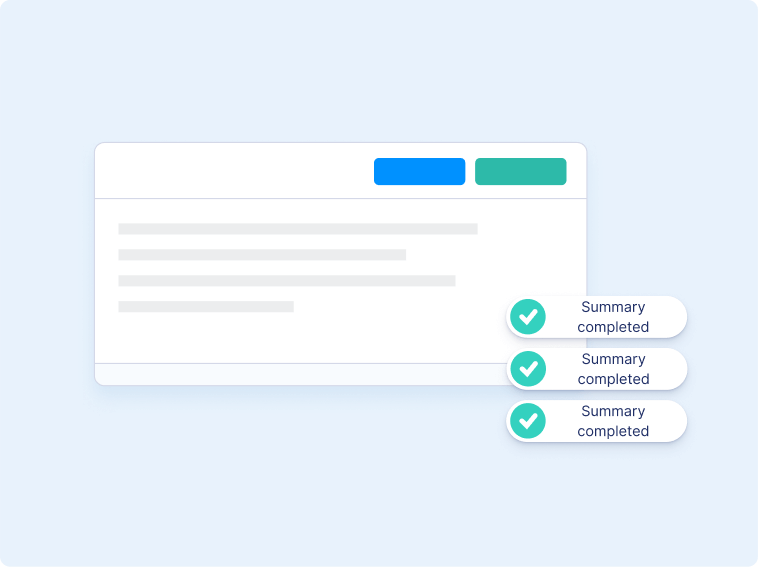
Why use this summarizer?
- 100% free: Generate unlimited summaries without paying a penny
- Accurate: Get a reliable and trustworthy summary of your original text without any errors
- No signup: Use it without giving up any personal data
- Secure: No summary data is stored, guaranteeing your privacy
- Speed: Get an accurate summary within seconds, thanks to AI
- Flexible: Adjust summary length to get more (or less) detailed summaries
How to use this summarizer
1. insert, paste or download your text, 2. pick the way you want to summarize, 3. adjust your summary length, 4. get your summary in seconds.
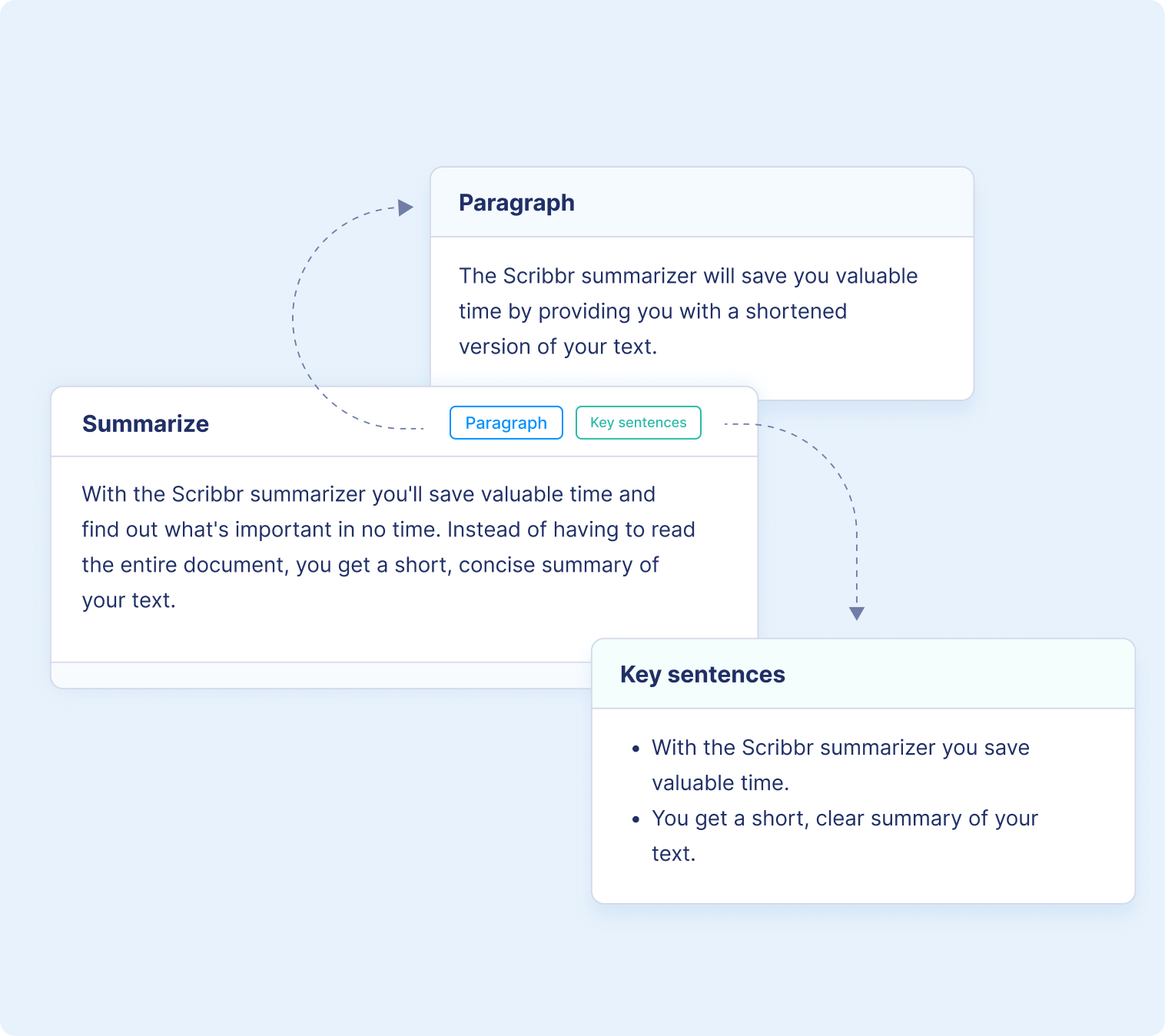
2 ways of summarizing your text
1. key sentences.
Extracts the key points of your text and turns them into digestible bullet points
2. Concise paragraphs
Summarizes your text in a concise paragraph
Summarize your text today
| 💸 Free | Unlimited text summarization |
|---|---|
| 🤖 AI-powered | Extract key points in seconds |
| 🎯 Accurate | Ideal for academic research |
| 🗎 Summarize any text | Articles, paragraphs & essays |
Want to make sure your summary doesn’t contain any plagiarism?
Scribbr & academic integrity.
Scribbr is committed to protecting academic integrity. Our plagiarism checker , AI Detector , Citation Generator , proofreading services , paraphrasing tool , grammar checker , summarizer, and free Knowledge Base content are designed to help students produce quality academic papers.
We make every effort to prevent our software from being used for fraudulent or manipulative purposes.
Ask our team
Want to contact us directly? No problem. We are always here for you.
- Email [email protected]
- Start live chat
- Call +1 (510) 822-8066
- WhatsApp +31 20 261 6040

Frequently asked questions
Yes, it can. The AI has been trained on a big dataset, so technical or complex data won’t be a problem for the text summarizer .
The text summarizer is accessible on both desktop and mobile.
This text summarizer can condense long text within seconds.
At the moment, a maximum of 600 words can be summarized at once, within a few seconds. Want to summarize more? Just paste another block of text. There’s no limit on how much text you can summarize with our text summarizer .
The text summarizer can give you a longer or shorter summary, depending on your wishes. Want a more detailed summary? Just adjust the summary length at the top.
- PRO Courses Guides New Tech Help Pro Expert Videos About wikiHow Pro Upgrade Sign In
- EDIT Edit this Article
- EXPLORE Tech Help Pro About Us Random Article Quizzes Request a New Article Community Dashboard This Or That Game Happiness Hub Popular Categories Arts and Entertainment Artwork Books Movies Computers and Electronics Computers Phone Skills Technology Hacks Health Men's Health Mental Health Women's Health Relationships Dating Love Relationship Issues Hobbies and Crafts Crafts Drawing Games Education & Communication Communication Skills Personal Development Studying Personal Care and Style Fashion Hair Care Personal Hygiene Youth Personal Care School Stuff Dating All Categories Arts and Entertainment Finance and Business Home and Garden Relationship Quizzes Cars & Other Vehicles Food and Entertaining Personal Care and Style Sports and Fitness Computers and Electronics Health Pets and Animals Travel Education & Communication Hobbies and Crafts Philosophy and Religion Work World Family Life Holidays and Traditions Relationships Youth
- Browse Articles
- Learn Something New
- Quizzes Hot
- Happiness Hub
- This Or That Game
- Train Your Brain
- Explore More
- Support wikiHow
- About wikiHow
- Log in / Sign up
- Education and Communications
How to Summarize a Journal Article
Last Updated: February 21, 2024 Approved
Reading Article
Planning draft, writing summary, sample summaries.
This article was co-authored by Richard Perkins . Richard Perkins is a Writing Coach, Academic English Coordinator, and the Founder of PLC Learning Center. With over 24 years of education experience, he gives teachers tools to teach writing to students and works with elementary to university level students to become proficient, confident writers. Richard is a fellow at the National Writing Project. As a teacher leader and consultant at California State University Long Beach's Global Education Project, Mr. Perkins creates and presents teacher workshops that integrate the U.N.'s 17 Sustainable Development Goals in the K-12 curriculum. He holds a BA in Communications and TV from The University of Southern California and an MEd from California State University Dominguez Hills. wikiHow marks an article as reader-approved once it receives enough positive feedback. This article has 24 testimonials from our readers, earning it our reader-approved status. This article has been viewed 1,417,771 times.
Summarizing a journal article is presenting a focused overview of a research study published in a peer-reviewed, scholarly source. A journal article summary provides readers with a short descriptive commentary, giving them some insight into the article's focus. Writing and summarizing a journal article is a common task for college students and research assistants alike. With a little practice, you can learn to read the article effectively with an eye for summary, plan a successful summary, and write it to completion.

- The purpose of an abstract is to allow researchers to quickly scan a journal and see if specific research articles are applicable to the work they are doing. If you're collecting research on immune system responses in rodents, you'll be able to know in 100 words not only whether or not the research is in your field, but whether the conclusions back up your own findings, or differ from it.
- Remember that an abstract and an article summary are two different things, so an article summary that looks just like the abstract is a poor summary. [1] X Research source An abstract is highly condensed and cannot provide the same level of detail regarding the research and its conclusions that a summary can.

- You still need to go back and actually read the article after coming to the conclusion, but only if the research is still applicable. If you're collecting research, you may not need to digest another source that backs up your own if you're looking for some dissenting opinions.

- Look for words like hypothesis, results, typically, generally, or clearly to give you hints about which sentence is the thesis.
- Underline, highlight, or rewrite the main argument of the research in the margins. Keep yourself focused on this main point, so you'll be able to connect the rest of the article back to that idea and see how it works together.
- In the humanities, it's sometimes more difficult to get a clear and concise thesis for an article because they are often about complex, abstract ideas (like class in post-modern poetics, or feminist film, for example). If it's unclear, try to articulate it for yourself, as best as you can understand the author's ideas and what they're attempting to prove with their analysis.
- Try to analyze the author's tone, looking at some of the keywords that really tells you what they are trying to get across to you.

- Different areas of focus within a journal article will usually be marked with subsection titles that target a specific step or development during the course of the research study. The titles for these sub-sections are usually bold and in a larger font than the remaining text.
- Keep in mind that academic journals are often dry reading. Is it absolutely necessary to read through the author's 500 word proof of the formulas used in the glycerine solution fed to the frogs in the research study? Maybe, but probably not. It's usually not essential to read research articles word-for-word, as long as you're picking out the main idea, and why the content is there in the first place.

- These segments will usually include an introduction, methodology, research results, and a conclusion in addition to a listing of references.

- When you're first getting started, it's helpful to turn your filter off and just quickly write out what you remember from the article. These will help you discover the main points necessary to summarize.

- Depending on the research, you may want to describe the theoretical background of the research, or the assumptions of the researchers. In scientific writing, it's important to clearly summarize the hypotheses the researchers outlined before undertaking the research, as well as the procedures used in following through with the project. Summarize briefly any statistical results and include a rudimentary interpretation of the data for your summary.
- In humanities articles, it's usually good to summarize the fundamental assumptions and the school of thought from which the author comes, as well as the examples and the ideas presented throughout the article.

- Any words or terms that the author coins need to be included and discussed in your summary.

- As a general rule of thumb, you can probably make one paragraph per main point, ending up with no more than 500-1000 words, for most academic articles. For most journal summaries, you'll be writing several short paragraphs that summarize each separate portion of the journal article.

- In scientific articles, usually there is an introduction which establishes the background for the experiment or study, and won't provide you with much to summarize. It will be followed by the development of a research question and testing procedures, though, which are key in dictating the content for the rest of the article.

- The specifics of the testing procedures don't usually need to be included in your summary in their entirety; they should be reduced to a simple idea of how the research question was addressed. The results of the study will usually be processed data, sometimes accompanied by raw, pre-process data. Only the processed data needs to be included in the summary.

- Make sure your summary covers the research question, the conclusions/results, and how those results were achieved. These are crucial parts of the article and cannot be left out.

- This is sometimes more important in summaries dealing with articles in the humanities. For example, it might be helpful to unpack dense arguments about poet George Herbert's relationship to the divine with more pedestrian summaries: "The author seeks to humanize Herbert by discussing his daily routines, as opposed to his philosophies."

- This can be difficult for some inexperienced research writers to get the hang of at first, but remember to keep the "I" out of it.

- Check verbs after writing. If you're using the same ones over and over, your reader will get bored. In this case, try to go back and really see if you can make really efficient choices.

Community Q&A
You Might Also Like

- ↑ https://owl.english.purdue.edu/owl/owlprint/930/
- ↑ https://student.unsw.edu.au/writing-critical-review
- ↑ http://web.pdx.edu/~jduh/courses/faq/JouranlArticleSearch.htm
- ↑ http://web.cortland.edu/hendrick/journalarticle.pdf
About This Article

To summarize a journal article, start by reading the author's abstract, which tells you the main argument of the article. Next, read the article carefully, highlighting portions, identifying key vocabulary, and taking notes as you go. In your summary, define the research question, indicate the methodology used, and focus mostly on the results of the research. Use your notes to help you stay focused on the main argument and always keep your tone objective—avoid using personal pronouns and drawing your own conclusions. For tips on how to read through the journal article thoroughly, such as starting with the conclusion, keep reading! Did this summary help you? Yes No
- Send fan mail to authors
Reader Success Stories
Lara Anthony
Nov 7, 2017
Did this article help you?

Mesfin Solomon
Mar 20, 2017
Juabin Matey
Sep 19, 2017
Mara Carrasco
Jan 23, 2017
Nurlan Yrysov
Sep 14, 2018

Featured Articles

Trending Articles

Watch Articles

- Terms of Use
- Privacy Policy
- Do Not Sell or Share My Info
- Not Selling Info
Get all the best how-tos!
Sign up for wikiHow's weekly email newsletter
How to Summarize Any Research Article Better: Proven Tips Outlined
Rev › Blog › Marketing › How to Summarize Any Research Article Better: Proven Tips Outlined
You’ve got content gold on your hands— primary and secondary research materials from some of the top market research companies. Now, it’s time to decide how it relates to your products, project, or consumers. What’s more, you need to distill each article’s essential parts into easy-to-read, accurate, informative, and, most importantly, concise summaries. Overwhelming? Maybe. Impossible? Heck no; you just need a good strategy. So, where to start?
You’ve landed on the right page! These tips and techniques provide a template to help guide you through the process.
Know Your Focus
The streaming TV hit, Cobra Kai, brings to mind Mr. Miyagi’s age-old wisdom– ‘Focus, Daniel-San.’ Focus is vital, as some sections of a research article are more relevant to your strategy than others.
For example, a summary crafted for a school project or a university may focus on the experiment itself. In contrast, the article’s results and discussion sections may be more relevant to consumer marketing or for a business model.
Once you establish your focus, you’re less likely to waste time.
Read The Research Article
But before you do, let’s look at the makeup of these articles. Market research, focus group data, and surveys usually consist of five or more sections.
- An abstract or hypothesis
- Explanation of the methods used
- Tests or experiments performed
- Summation and or discussion of the results
- A list of references or source materials
Read The Abstract
Since some of the research articles you find will not work for your purpose, you should always start with the abstract. It’s an overview of the data and explains the purpose of the study as well as the expected results. So you’ll know whether to include the article or move on to the next piece of research.
Take Good Notes
The next step– read the article from abstract to references. But be prepared! Your mind may wander when faced with numbers, statistics, and long-winded wording. So grab your highlighter and pen and start taking notes.
Depending on the space available, you can write your notes in the margin. If you’re in a time crunch, check out Rev . We’ve designed a convenient application perfect for taking notes! Download our Voice Recorder App for free and read your notes out loud. You’ll get a 99% accurate transcription of your summary notes sent to your email or account with a simple tap.

Research Hack: As an overview, a research article may not include every insight from the participants, interviews, or market data. Take a look at the references. You may find some hidden gems that will help your strategy stand out.
Outline Your Thoughts
You’ve made notes, sifted through the numbers and statistics; but, there’s still a ton of information. An outline will make your writing process much more efficient. Although each research article is relatively straight-forward, you want your summary to stay on strategy.
Write A Summary
Okay, you’re ready to condense someone else’s work. Rather than stress over grammar and length, take the pressure off by writing a rough draft. Use key points from your notes, REV transcriptions, your outline, and the research article’s sections as your guide.
Identify The Goal And The Methods Used
Like the author’s abstract, the beginning of your summary should address the research article’s fundamental objective . This section may also include critical details about demographics, customer behavior, or trends. When summarizing, consider three key questions.
- What is the goal of the research?
- What methods did the author(s) use?
- Are potential obstacles to success listed?
Methods vary in market research. You may have focus groups , in-depth interviews , or online discussions. Depending on the reason for your summary, the raw audio or video clips used in the study may hold nuggets. If full transcripts aren’t available, save time by uploading the clips to Rev. Our human transcription service costs $1.50 per minute, and we offer a 99% accuracy guarantee. We also offer a more cost-effective A.I. speech-to-text solution for only $0.25 per minute .
Describe The Observations
The experiment is the “meat” of the research. In your own words, briefly explain what the author(s) observed as the testing played out in real-time. You can talk about the time it took participants to complete tasks or directives. Were they excited about the client’s brand or disinterested? Basically, you’re recapping the participant’s reactions.
Discuss The Outcome
As with any study, the results make or break the goal of the research. Was the test successful? Was anyone surprised by the outcome, or were there any unexpected developments? Pay careful attention to detail as you layout all conclusions reached by the author(s).
Article Summary Quick Tips: Do This, Not That
Is your head spinning yet? You can simplify the editing process by following these technical takeaways.
- Be Careful Not To Draw Your Own Conclusions: You are summarizing the results of the research. The last thing you want to do is editorialize your summary. To avoid this, use the third-person point of view and present tense.
- Keep Your Copy Clean And Free Of Errors: Reread your text. Eliminate words like “that,” “in fact,” “however,” and adverbs. Make sure your summary is accurate. Then, use free websites like Hemingway App or paid services such as Grammarly to check for grammar or spelling issues.
- Watch For Plagiarism: Unless you’re using a word coined by the researcher, paraphrase your text. If you notice similar wording in your summary, reread the article so you can explain the data in your own words.
- Cite Your Sources: Steer clear of directly quoting the research. It’s best to paraphrase the data and reference the source using: the name of the university, the name of the journal and year of publication, or the name of the researcher, team, or society and year of study.
Finalize Your Article Summary
Remember, you want your summary to be clear, straight-forward, and compelling. The market research article or study you’ve chosen may prove vital to you or your client’s business strategy and brand analysis. Take your time. Read and reread your summary. Make sure it’s representative of the research. And always triple-check your text for technical and factual accuracy.
Related Content
Latest article.

How to Analyze Focus Group Data
Most popular.

Differences in Focus Groups & In-Depth Interviews for a Successful Market Research
Featured article.

How to Use Automatic Transcription as a Marketing Professional
Everybody’s favorite speech-to-text blog.
We combine AI and a huge community of freelancers to make speech-to-text greatness every day. Wanna hear more about it?
Extract key information from research papers with our AI summarizer.
Get a snapshot of what matters – fast . Break down complex concepts into easy-to-read sections. Skim or dive deep with a clean reading experience.
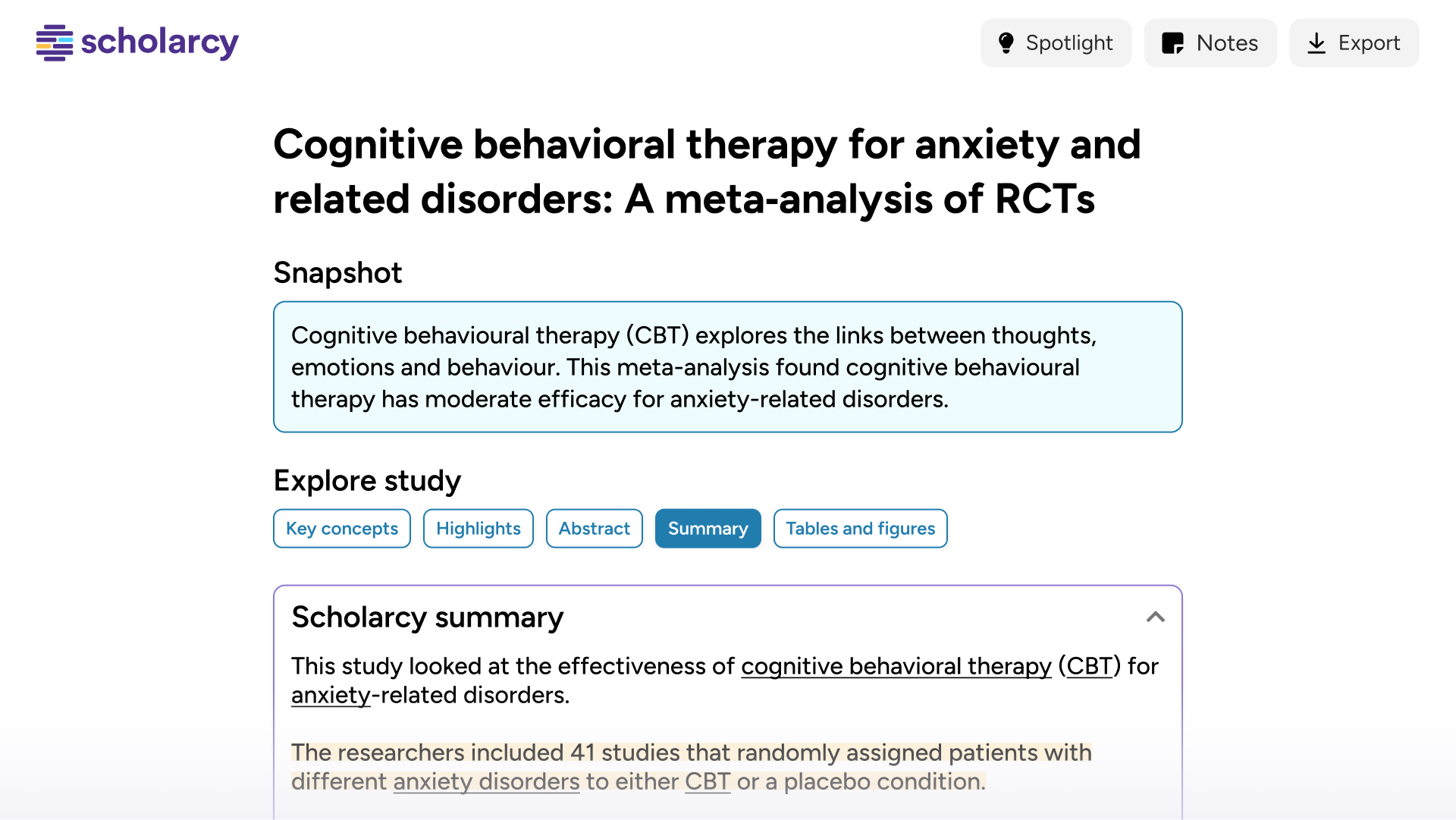
Summarize, analyze, and organize your research in one place.
Features built for scholars like you, trusted by researchers and students around the world.
Summarize papers, PDFs, book chapters, online articles and more.
Easy import
Drag and drop files, enter the url of a page, paste a block of text, or use our browser extension.
Enhanced summary
Change the summary to suit your reading style. Choose from a bulleted list, one-liner and more.
Read the key points of a paper in seconds with confidence that everything you read comes from the original text.
Clean reading
Clutter free flashcards help you skim or diver deeper into the details and quickly jump between sections.
Highlighted key terms and findings. Let evidence-based statements guide you through the full text with confidence.
Summarize texts in any format
Scholarcy’s ai summarization tool is designed to generate accurate, reliable article summaries..
Our summarizer tool is trained to identify key terms, claims, and findings in academic papers. These insights are turned into digestible Summary Flashcards.
Scroll in the box below to see the magic ⤸

The knowledge extraction and summarization methods we use focus on accuracy. This ensures what you read is factually correct, and can always be traced back to the original source .
What students say
It would normally take me 15mins – 1 hour to skim read the article but with Scholarcy I can do that in 5 minutes.
Scholarcy makes my life easier because it pulls out important information in the summary flashcard.
Scholarcy is clear and easy to navigate. It helps speed up the process of reading and understating papers.
Join over 400,000 people already saving time.
From a to z with scholarcy, generate flashcard summaries. discover more aha moments. get to point quicker..
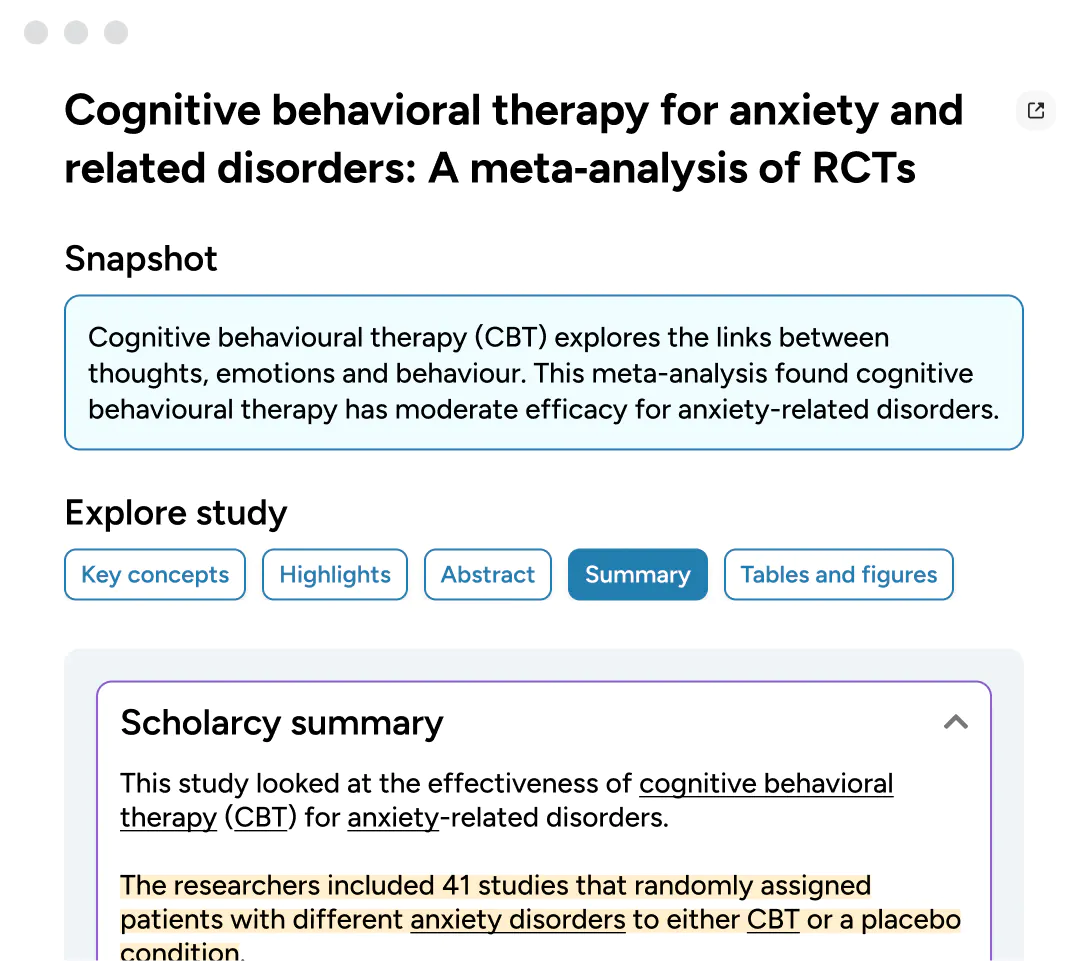
Understand complex research. Jump between key concepts and sections. Highlight text. Take notes.
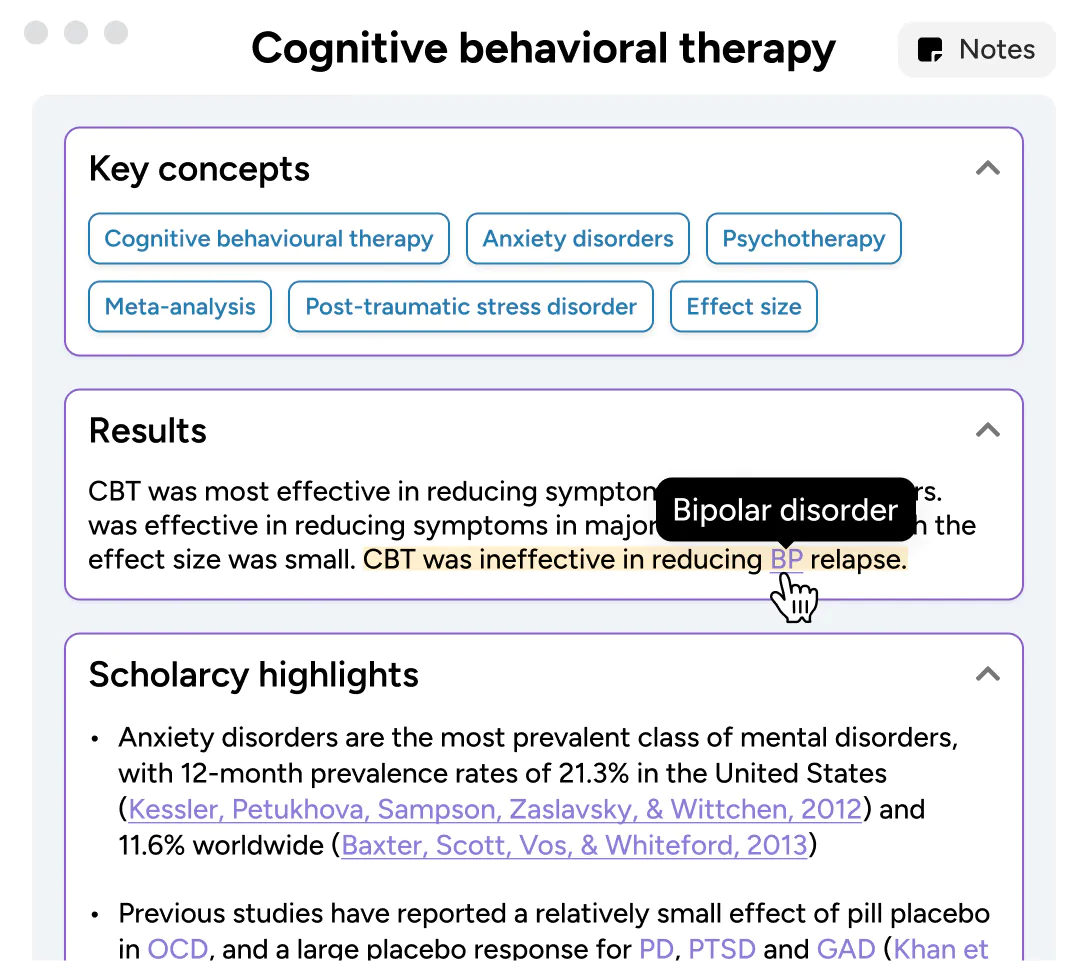

Build a library of knowledge. Recall important info with ease. Organize, search, sort, edit.
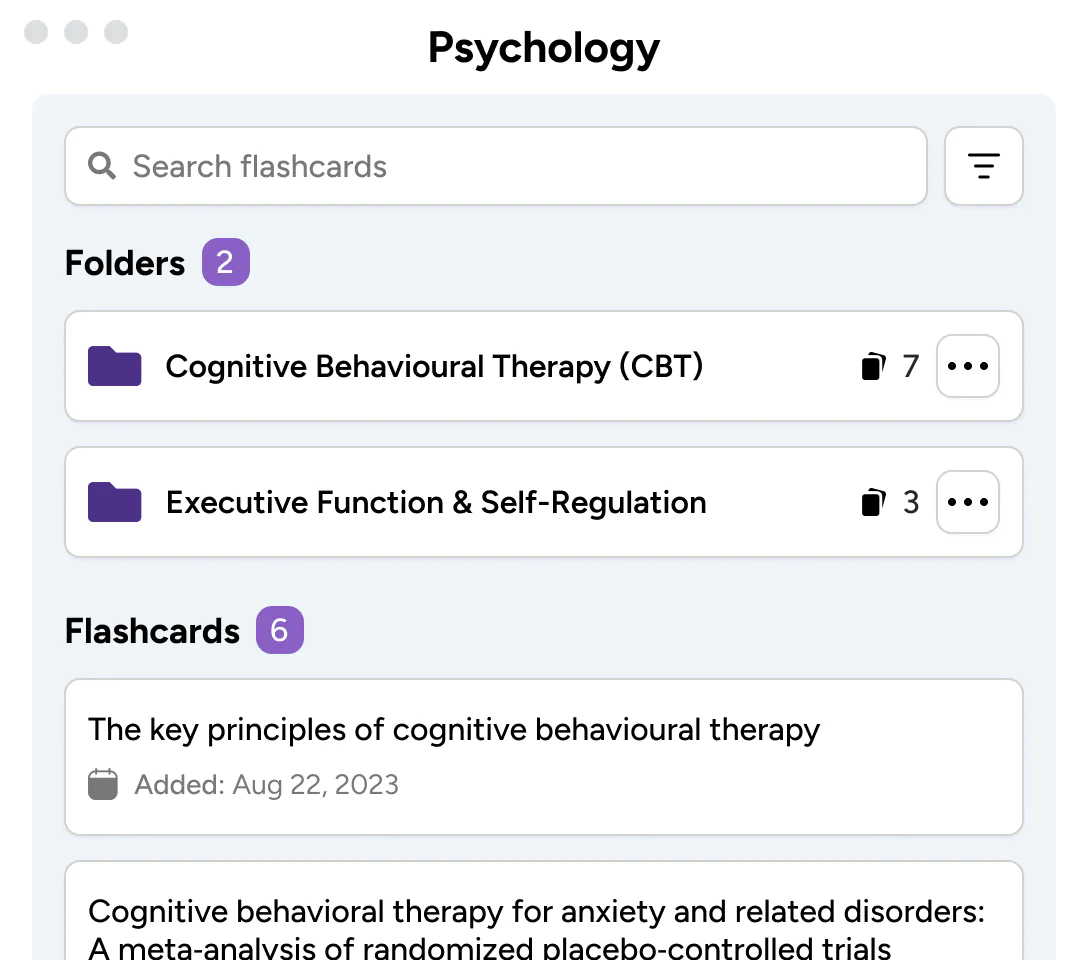
Bring it all together. Export Flashcards in a range of formats. Transfer Flashcards into other apps.
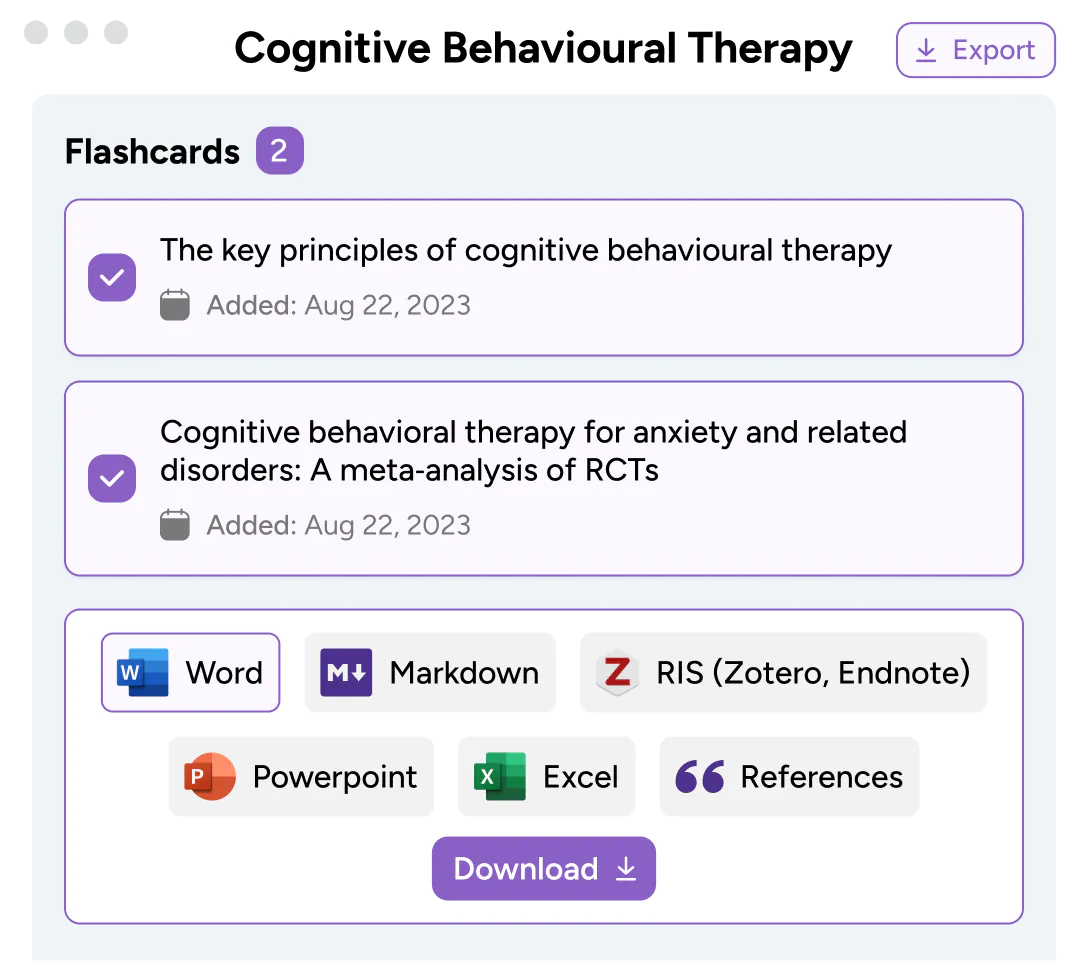
Apply what you’ve learned. Compile your highlights, notes, references. Write that magnum opus 🤌

Go beyond summaries
Get unlimited summaries, advanced research and analysis features, and your own personalised collection with Scholarcy Library!
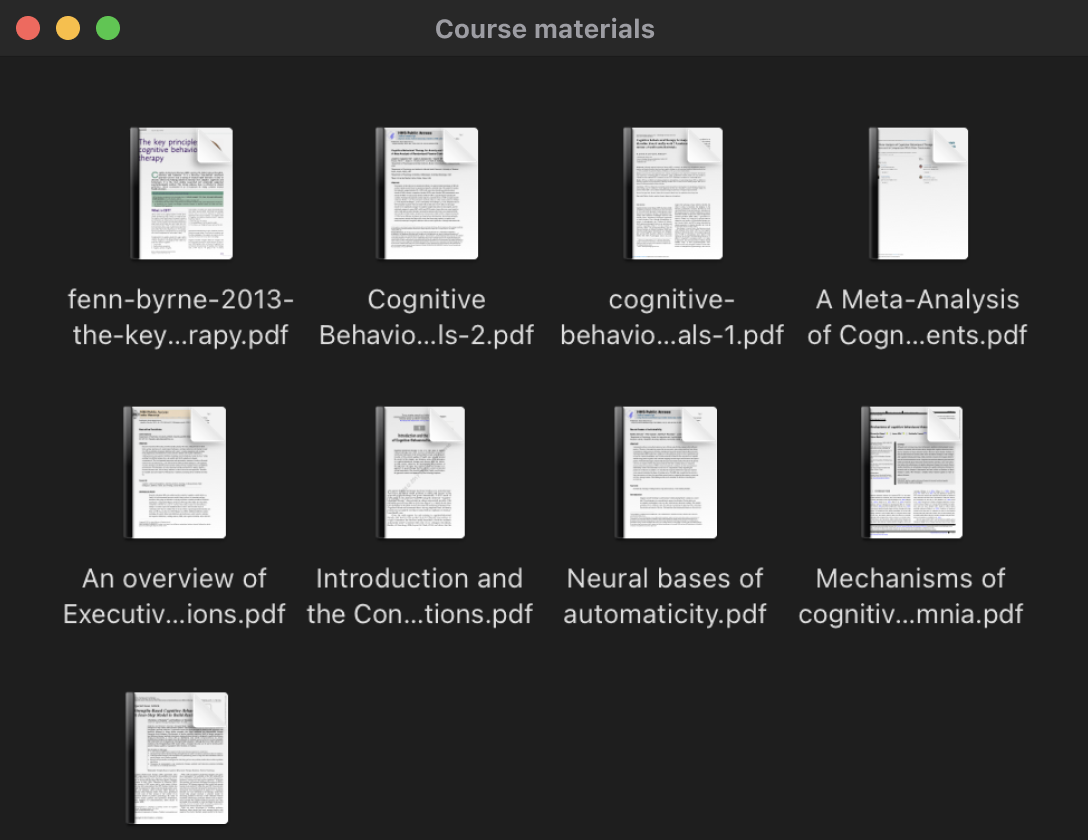
With Scholarcy Library you can import unlimited documents and generate summaries for all your course materials or collection of research papers.

Scholarcy Library offers additional features including access to millions of academic research papers, customizable summaries, direct import from Zotero and more.

Scholarcy lets you build and organise your summaries into a handy library that you can access from anywhere. Export from a range of options, including one-click bibliographies and even a literature matrix.
Compare plans
Summarize 3 articles a day with our free summarizer tool, or upgrade to Scholarcy Library to generate and save unlimited article summaries.
Import a range of file formats
Export flashcards (one at a time)
Everything in Free
Unlimited summarization
Generate enhanced summaries
Save your flashcards
Take notes, highlight and edit text
Organize flashcards into collections
Frequently Asked Questions
How do i use scholarcy, what if i’m having issues importing files, can scholarcy generate a plain language summary of the article, can scholarcy process any size document, how do i change the summary to get better results, what if i upload a paywalled article to scholarcy, is it violating copyright laws.

- Library Catalogue
Summarizing: How to effectively summarize the work of others
On this page, strategies for summarizing, a summary case study.
Academic writing requires you to research the work of other scholars, develop your own ideas on the topic of your research, and then to think about how your ideas relate to the scholarship that you have researched. Three main ways of responding are to generally agree, generally disagree, or both agree and disagree with another author’s perspective on a subject. You can think of agreeing and disagreeing as being like saying, “Okay, but….” Being able to effectively summarize the work of other researchers will help you both to determine your own position and also clearly communicate the connections between your ideas and the ideas of others. In other words, knowing how to effectively summarize the ideas of others helps you to bring those ideas into dialogue with your own.
When you summarize, you explain the main idea(s) from someone else’s work. Note that you must include citation information for summaries -- think of your citation as showing your reader where they can find the original or “full” version of the work that you have summarized.
In They Say/I Say, Gerald Graff and Cathy Birkenstein describe summarizing as “putting yourself in the shoes of someone else” (2014, p. 31). They use this description because effective summarizing requires that you engage with and aim to understand someone else’s ideas or perspective, even if you disagree. It can be helpful to think of a summary as a brief description of someone else’s work that they, themselves, would recognize and consider to be a fair representation.
Try these steps for writing summaries:
- Select a short passage (about one to four sentences) that supports an idea in your paper.
- Read the passage carefully to fully understand it.
- Take notes about the main idea and supporting points you think you should include in your summary. Include keywords and terms used by the author and think, too, about how the source ideas are relevant to the argument(s) that you are presenting in your paper.
- Using only your notes, explain the original author’s main ideas to someone else. Then explain how those ideas support or conflict with your own argument.
- Reread the original source. Is there important information that you have forgotten or misremembered? Is your summary very similar to the original source?
- Add in-text citation and check the required formatting style.
An effective summary is a way of communicating to your reader what the source text is “about.” However, even while it is important to “put yourself in the shoes” of the original author, you also need to know what it is that you are arguing in your paper that has led you to include this other perspective. Because a scholarly article is rarely about one simple thing, knowing what you are arguing will help you to determine the most important ideas of the original source for your paper.
Below is an example of an ineffective, list-like summary, followed by an effective summary.
Original source to be summarized
“Before 1994, diabetes in children was generally caused by a genetic disorder – only about 5 percent of childhood diabetes cases were obesity-related, or Type 2, diabetes. Today, according to the National Institutes of Health, Type 2 diabetes accounts for at least 30 percent of all new childhood cases of diabetes in this country. Not surprisingly, money spent to treat diabetes has skyrocketed, too. The Centers for Disease Control and Prevention estimate that diabetes accounted for $2.6 billion in health care costs in 1969. Today’s number is an unbelievable $100 billion a year.”
“Don’t Blame the Eater,” David Zinczenko [1]
Ineffective list-like summary
The author says that only 5 percent of children had Type 2 diabetes before 1994. In addition, they mention that today at least 30 percent of new childhood diabetes cases in the USA are Type 2. They also say that more money is being spent to treat diabetes now -- $100 billion a year.
Effective summary
In author's article “Don’t Blame the Eater,” David Zinczenko supports their position on the fast food industry by comparing today’s rates of Type 2 diabetes to those prior to 1994. David makes it clear that instances of Type 2 diabetes have increased dramatically, as has the cost of preventing the spread of this disease.
An effective summary doesn’t just report source information but also indicates concisely how the ideas connect and why they matter. You will also notice that the second example mentions the name of the author and the article, which is an important way of signalling to your reader that you are referring to someone else’s work, rather than presenting your own original ideas.
[1] Example taken from Graff, G. & Birkenstein, C. (2014). They say/I say: The moves that matter in academic writing. New York and London: W.W. Norton & Company.
How to Summarize an Article More Effectively (Using AI)

Table of contents

Dana Nicole
Experts like TED Talk speakers are experienced in taking vast topics and condensing them into brief talks.
Nowadays, you can summarize texts even faster using AI technology.
It doesn't matter if the topic is as complex as neuroscience and interstellar travel, using the right tools and methodology you can distill large amounts of information into a scannable summary.
In this article, I will share three tools that have completely transformed how I research and summarize articles:
- A summarization tool that uses AI to produce a reliable summary of the article.
- Three quick-round reading sessions to get the information summary structured in your head.
- A writing method that guarantees your summary stays plagiarism-free.
Free AI Summarizer > Free AI Summarizer >
How to summarize any article in six easy steps
TED has three simple principles for scripting talks:
- Focus on one major idea
- Make sure the script has a structure
- Ensure each point has a purpose and speaks to your audience
Keeping these principles in mind, we can follow a solid six-step framework to summarize articles.
Step 1: Start summarizing by knowing who you are writing for
Shayla Price, founder of PrimoStats , describes the biggest mistake people make when writing article summaries is that they don’t write for a specific person:
“Writers forget to add details that matter to their specific audience. Article summaries must adjust based on your target audience's goals and concerns. Answer the question: What should my audience do with this new information? ” - Shayla Price
To define your audience, read the article’s abstract for a general understanding of what’s inside. While reading the abstract, think about who will read your summary:
- What’s their level of understanding on the subject?
- What information would they find useful?
- What information is irrelevant?
For example, a summary for an article talking about color psychology can have different audiences that require different information:
- A team lead at a marketing agency might want information about color psychology relating to buyer behavior
- An instructor grading a paper you’re writing might want information proving or disproving the thesis for your paper
- Readers of a graphic design blog might want information discussing the validity of color psychology
After setting your audience, you’ll know which information is pertinent for your summary.
Step 2: Read the article three times
TED speakers don’t hop on stage without a deep understanding of the topic they’re presenting, and you can’t write a summary without one either.
A quick pass through your article won’t cut it, but luckily, you don’t need to read it ten times either. Three rounds is plenty.
First round
Consider your first round your passive round. This round is equivalent to laying on a beach with your favorite book. No critical thinking. No re-reading passages over and over to understand them. Your goal is to get the gist of what’s going on within the pages of the article—that’s all.
Second round (PDF summarization example)
Time to start active reading. Highlight important concepts and leave questions in the margins for concepts you don’t understand.

A symbol legend can also be helpful to organize your thoughts, like color-coding your highlights or using symbols to denote key points.

But be careful you aren’t mindlessly highlighting as you read through the text, otherwise you’ll end up too many highlights that don’t provide any value:

To help you highlight, upload the article to Wordtune via a PDF, a link to the report, or copy and paste the in the text.

With the highlighted article from Wordtune, I can quickly identify and review key points.

Third round
Finally, go through the article one last time and answer the questions you left in the margins. Answering remaining questions gives you a solid understanding of the paper so you’re well-equipped to summarize it.
Step 3: Summarize each page, without plagiarism
Time to write summaries for each page or, if it makes sense, each core section.
Page-level summaries ensure you don’t forget anything relevant when writing a summary for the entire article.
When I uploaded a research paper to Wordtune, I got 31 brief summaries. I can copy those summaries and keep them in a separate document. That way, I know I won’t leave out any essential points when I go to write my own summary.

If the summaries don’t fit the audience you intend to write for, you can click the “rewrite” button until you find one that’s suitable. Wordtune will help you make sure you summarize the article without plagiarism , since the summarization is automatically paraphrased.

As you read through each of Wortune’s summaries, think back to your target audience. Save any summaries you think they’d find useful by copying or exporting them.
Step 4: Write your summary’s first draft
With Wordtune’s summaries and your marked-up article, it’s time to piece everything together. Again, we can take some direction from TED Talks. TED encourages speakers to have a structured script with a clear beginning, middle, and end.
To write a summary with a clear structure, I recommend using the Inverted Pyramid framework—a journalistic framework designed to take long stories and condense them into bite-sized bits.
- Title of the research paper and author
- Key findings
- Methodology for research
- Supporting research
- Why your audience should care about the findings
- Discuss any limitations
- Review the findings
How to summarize articles with the Inverted Pyramid framework
Front load all essential information for your summary with the necessary data your reader needs to know. Include what the study was about (the hypothesis), citations (title of research paper and author), and key findings.
As you’re writing, ask yourself, “ why would my audience find this information useful? ” If they wouldn’t find it useful, don’t include it.
Within the middle of your summary, include any details that support the points from above and expand on why your audience should care. This might be methodologies or supporting research mentioned throughout the article.
Finish off your summary by discussing any limitations within the research paper, and review the findings one last time so your reader walks away with a clear understanding of your summary.
Other tips for writing your summary
Keep it short.
TED Talks have an 18-minute time-limit. Any longer, and TED knows the audience may lose interest. Your summaries should have a limit, too.
Charlene Burke , a business research professional and copywriter, who has 20 years of experience summarizing research papers, marketing research, and competitive intelligence reports says to keep your summary to 10% of the original text. Comb through your sentences and remove any that don’t add value or context to the main point.
Cite and reference
Always reference the author and name of the paper within the first few sentences so your reader knows right away you’re summarizing an article, rather than coming up with the ideas yourself.
If your summary is several paragraphs long, you can also include citations throughout , as a subtle reminder to the reader that again, the ideas you’re presenting aren’t yours.
Focus on one idea
If you present too many findings in your summary, your reader may get confused or you may weaken the research. To pick the one idea that matters most, revisit the audience you set for your summary and what matters to them. Make sure the idea you present in your summary aligns with the information they’ll find most relevant.
Step 5: Edit and polish

Every great writer’s secret weapon? A few rounds of editing .
To start, make sure your summary doesn’t leave your reader longing for more.
For example:
“Color psychology is a popular topic but it might not be creditable.”
This sentence leaves me with questions: Who is color psychology popular with? Why isn’t it creditable?
We can improve this sentence by adding a bit more context:
“Color psychology is popular among graphic designers, but the subject lacks empirical evidence on how it affects buyers’ decisions.”
Afterwards, clean up your summary by fixing clunky sentences . For example:
- Clunky : Although many studies place a focus on a person’s psychological, physiological, and behavioral responses to color, the findings of these studies are often based on small sample sizes and/or small sample groups.
- Fixed : ”Most studies focus on psychological, physiological, and behavioral responses to color, but the findings are often based on small sample sizes.”
Using Wordtune , I rewrote the first sentence and it went from 33 words to 21. The second sentence gets to the point much faster and is easier to read.
Finally, fix any last-minute grammar or spelling mistakes.
Step 6: Get someone else to read your summary
I call this step “the mom test” but you can call it whatever you’d like. Whenever I need to summarize something, I ask my mom to read through my work.
If she understands the main points without knowing about the topic, I know I’ve done a decent job.
Have someone who isn’t familiar with the research paper read through your summary. Does it make sense to them? What unanswered questions do they have after reading it? If you need, go through one final round of edits.
Write article summaries faster with Wordtune
Summarizing articles doesn’t need to be a tedious task that takes hours to complete. Wordtune helps you fast-track the process so you can write compelling summaries in a fraction of the time.
Share This Article:
%20(1).webp)
8 Tips for E-commerce Copywriting Success (with Examples!)
.webp)
The Brand Strategy Deck You Need to Drive Social Media Results + 5 Examples

Grammarly Alternatives: Which Writing Assistant is the Best Choice for You?
Looking for fresh content, thank you your submission has been received.
Protect your data
This site uses cookies and related technologies for site operation, and analytics as described in our Privacy Policy . You may choose to consent to our use of these technologies, reject non-essential technologies, or further manage your preferences.
- Resume and Cover Letter
- 27 Great Resume Summary...
27 Great Resume Summary Examples to Get Hired
20 min read · Updated on June 03, 2024

Your resume summary is the first impression you make on potential employers, so it's crucial to get it right
When it comes to job applications, your resume is often the first point of contact with prospective employers. It's essential to make a good impression right from the start and that's where your resume summary comes in. Your summary is a brief statement at the top of your resume that highlights your skills , experiences , and achievements , making it a key part of your job application.
In this article, you'll learn how to write the ultimate resume summary that will grab the attention of recruiters and hiring managers. You'll discover what makes a good summary and what to avoid, as well as how to sell yourself effectively to potential employers.
You may be wondering: what exactly is a resume summary and how do I write one? We'll answer these questions and provide examples of professional summaries for various industries.
By the end of this article, you'll have a comprehensive understanding of what it takes to create a standout resume summary that will help you to land your dream job.
What is a resume summary?
To understand a resume summary, it's important to understand the challenge that good summaries are designed to overcome. Employers who are looking for new hires often need to compare many dozens or even hundreds of resumes to find the best candidates for the job. Few hiring personnel have the time needed to thoroughly examine every single resume that they receive.
Instead, employers typically spend no more than five or six seconds scanning any given resume. If a resume manages to capture their interest in those few seconds, they'll take the time to read it in greater detail.
However, if your resume doesn't grab their attention, it's likely to be rejected without any further examination. So, the challenge is to find a way to quickly earn the reader's interest and inspire them to read the rest of the document.
That's where your resume summary comes into play. As you'll see from our resume summary examples, a good summary is the resume equivalent of a salesperson's elevator pitch.
This brief statement should highlight your experience and job title, one or two key skills, and a couple of your most prominent achievements. When your summary is crafted well, it will provide the employer with a quick overview of your potential value as a new hire.
Once you've written your summary, you should place it right after your contact information and resume headline , so that it's the first thing employers see. If you've done your job properly, that summary will be compelling enough to make the reader want to learn more about the type of value you can bring to the job.
How should you start a resume summary?
After your headline, you should include a brief opening statement that summarizes who you are. This statement should be concise and compelling, and it should clearly communicate your unique value proposition. Here are some examples of strong opening statements:
Innovative Marketing Manager with over five years of experience in developing and executing successful campaigns for Fortune 500 companies
Results-driven Sales Executive with a proven track record of exceeding revenue targets and building strong client relationships
Skilled Customer Service Representative with expertise in problem-solving, conflict resolution, and communication
Tips for writing a resume summary
To make sure you get your summary spot on, follow our top tips:
Be specific
When writing a resume summary, it's essential to be specific and quantify your achievements wherever possible. Instead of saying, "Experienced marketing professional," try saying, "Experienced marketing professional with expertise in managing successful social media campaigns, resulting in increases of up to 30% in website traffic."
This provides concrete evidence of your skills and demonstrates your value to potential employers.
Reflect on your career
When it comes to writing a strong resume summary, you should engage in some self-reflection. Before putting pen to paper (or fingers to keyboard), take some time to think about your key skills, experiences, and achievements. This will help you to identify the most important information to include in your summary. Review your past roles, responsibilities, and accomplishments, and think about how they relate to the job you're applying for. Ask yourself:
What have I achieved in my career?
What skills have I developed?
What makes me stand out from other applicants?
Identify your key skills
One of the most important things to include in your resume summary is your key skills. These are the abilities that set you apart from other candidates and demonstrate your value to potential employers. Begin by making a list of your top skills, then prioritize them based on relevance to the job you're applying for.
Highlight your relevant experiences
Next, think about relevant experiences that you can include in your summary. This includes any previous jobs or internships, volunteer work, or extracurricular activities that have given you valuable experience. Consider what you've learned and achieved in each role and how that relates to the job you're applying for.
You should focus on what is most relevant to your target job. Here are some examples:
Proven ability to increase sales revenue by 20% year on year
Expertise in project management and team leadership
Proficient in Adobe Creative Cloud and Microsoft 365
Confident working with a diverse range of clients and stakeholders
Keep it concise
Remember, your resume summary should be concise and to the point. Stick to the most important information and avoid filler words or irrelevant details. A good rule of thumb is to keep your summary to 3-5 sentences.
Use action verbs
When describing your experiences and achievements, use strong action verbs and adverbs to convey a sense of accomplishment and momentum. For example, instead of saying, "Responsible for managing social media accounts," say, "Successfully manages social media accounts."
Quantify your achievements
Wherever possible, use numbers and statistics to quantify your achievements. This provides concrete evidence of your skills and demonstrates your value to potential employers. For example, instead of saying, "Helped to increase sales," say, "Helped to increase sales by 20% in the first year."
Tailor it to the job
Make sure your resume summary is tailored to the job you're applying for. This means highlighting the skills and experiences that are most relevant to the role. Look at the job description and identify the key requirements, and then make sure your summary addresses these points.
Professional resume summary examples
Since there's nothing quite like seeing an example of a great summary, we've compiled twenty-seven great resume summary examples that you can use as inspirational templates for your own perfect resume . Below, you'll find summary examples for a variety of different job roles, including:
Customer Service Representative
Sales Representative
Marketing Manager
Project Manager
Software Developer
Human Resources Manager
Graphic Designer
Registered Nurse
Financial Analyst
Administrative Assistant
Data Entry Clerk
Business Analyst
Operations Manager
Mental Health Counselor
High School Teacher
Event Manager
Digital Marketing Manager
Content Marketer
SEO Specialist
Bank Teller
Software Support Specialist
Data Scientist
Dental Assistant
1. Customer Service Representative resume summary example
"Highly motivated Customer Service Representative with 5 years of experience in delivering service excellence. Skilled in conflict resolution and problem-solving, resulting in a 95% customer satisfaction rate. Proven ability to multitask in fast-paced environments while maintaining accuracy and attention to detail."
Why it works : This summary highlights the candidate's experience and skills while also showcasing their relevant achievements in ensuring customer satisfaction. It mentions how much experience they have and calls out a measurable success.
2. Sales Representative resume summary example
"Dynamic Sales Representative with a track record of exceeding sales quotas by 20%+. Proficient in consultative sales techniques and relationship building. Exceptional communication and negotiation skills with the ability to close deals."
Why it works : This summary provides a quantifiable achievement to show the candidate's success in their previous sales roles while also highlighting their key skills in relationship building and communication.
3. Marketing Manager resume summary example
"Strategic Marketing Manager with 7+ years of experience in developing and executing successful marketing campaigns across multiple channels. Skilled in market research and analysis, campaign optimization, and team leadership. Proven track record of driving revenue growth and increasing brand awareness."
Why it works : This summary emphasizes the candidate's experience and leadership skills while also showcasing their ability to drive results through successful marketing campaigns. The candidate has also demonstrated their ability to grow revenues and raise brand awareness.
4. Project Manager resume summary example
"Accomplished Project Manager, with confidence in leading cross-functional teams and managing project timelines, budgets, and resources. Strong communication and collaboration skills, with the ability to build relationships with stakeholders. Proven track record of delivering projects on time and within budget."
Why it works : This summary highlights the candidate's extensive project management experience and emphasizes their ability to successfully deliver projects while working with multiple stakeholders.
5. Software Developer resume summary example
"Innovative Software Developer with 5+ years of experience in designing, developing, and implementing complex software applications. Skilled in programming languages including Java, Python, and C++. Demonstrated ability to work collaboratively in Agile environments to deliver high-quality code on time."
Why it works : This job seeker has taken the time to highlight some of the technical skills they possess, while emphasizing their ability to work in Agile environments. They also call attention to the fact that they can take a software development project from design to implementation.
6. Human Resources Manager resume summary example
"Experienced Human Resources Manager specializing in talent acquisition, employee relations, and performance management. Skilled in developing and implementing HR policies and procedures that align with business objectives and values. Proven track record of building and managing high-performing teams."
Why it works : This summary highlights the candidate's experience in various HR functions and emphasizes their ability to build and manage teams. It also shows that they can perform managerial functions like developing policies and procedures.
7. Graphic Designer resume summary example
"Creative Graphic Designer with particular expertise in developing and executing visually stunning designs for print and digital media. Proficient in Adobe Creative Cloud, with a focus on typography and layout. Strong communication and collaboration skills, with the ability to work on multiple projects simultaneously."
Why it works : This summary works well because it showcases their technical skills and experience while also emphasizing creativity and an ability to work collaboratively.
8. Registered Nurse resume summary example
"Compassionate Registered Nurse with over 10 years' experience in providing high-quality patient care. Skilled at patient assessment, medication administration, and treatment plan development. Strong communication and interpersonal skills with the ability to build rapport with patients and their families."
Why it works : This summary emphasizes the candidate's clinical and patient care experience and highlights their key nursing and interpersonal skills.
9. Financial Analyst resume summary example
“Detail-oriented Financial Analyst with a strong background in financial modeling, data analysis, and forecasting. Combines advanced Excel skills with the ability to create and manage financial reports. Able to work collaboratively with cross-functional teams.”
Why it works : This summary showcases the applicant's specific skills and experience in financial analysis and highlights their proficiency in Excel, a crucial tool for the role.
10. Administrative Assistant resume summary example
“Skilled Administrative Assistant with 8 years of experience in administrative support and office administration. Resilient, detail-oriented, and able to work under extreme pressure in a team environment. Excellent interpersonal, client management, and interdepartmental liaison skills. Committed to successful management of multiple simultaneous projects, strict adherence to deadline requirements, and accurate maintenance of schedules, meeting obligations, and records.”
Why it works : An Administrative Assistant wears many hats and experiences many challenges. This resume summary covers a lot of ground to demonstrate that the candidate understands those obstacles and knows how to overcome them.
11. Data Entry Clerk resume summary example
“Task-driven and results-oriented professional with more than 10 years of experience in data entry, project coordination, and customer service. Uses interpersonal skills including effective communication to build rapport and positive relations with customers, gather vital information, and ensure rapid and accurate entry of data into designated software programs.”
Why it works : This resume summary is effective because it gets right to the heart of the job: dealing with customers and entering data into databases. The candidate also emphasizes their results-focused mindset, project skills, and key soft skills.
12. Business Analyst resume summary example
“Results-driven Business Analyst with a proven record in expanding profitability by 55% in the retail industry. Confident carrying out data-focused analysis that provides key insights and recommendations for growth strategies. Strong interpersonal and team building skills, innovative approach to problem-solving , and resolute commitment to efficiency and productivity.”
Why it works : Business analysis is all about using data and research to deliver key insights that result in improved operations and greater business success. This summary hits all the right notes as it focuses on key skills, a solutions-oriented mindset, and notable achievements that reflect real value for employers.
13. Operations Manager resume summary example
“Results-oriented Operations Manager with more than 10 years of supervisory experience in high-level operational environments. Adept at coordinating both large and small teams, outside consultants, and mid-level management personnel. Successfully introduced Lean manufacturing principles that reduced costs by 32% via waste elimination and process revitalization.”
Why it works : This candidate's summary emphasizes key skills that the employer wants to see in any managerial candidate, while also showcasing their knowledge of best operational practices and a commitment to cost reduction.
14. Mental Health Counselor resume summary example
“Compassionate Mental Health Counselor with more than a decade of experience addressing mental health issues and behavioral concerns. Proven success in both individual and group counseling environments, assisting clients in gaining insight and understanding of their unique conditions. Specialized focus on working with young adults and families, with an emphasis on addressing substance abuse root causes and other social factors involved in mental health.”
Why it works : This resume summary is notable for citing important skills like empathy and compassion. It also focuses attention on the candidate's experience in dealing with common mental health concerns and hints at their preferred approach to assisting patients.
15. High School Teacher resume summary example
“Dynamic high school teacher with 12 years of experience developing approved curricula for more than 500 students in grades 9-12. Proven track record of helping students to achieve a 98% passing rate in both Western Civilization and World History instruction. Actively engaged in every aspect of education, at the district, local, and parent-teacher level.”
Why it works : This candidate's resume summary highlights their vast experience, while illustrating their success in ensuring that their students learn what they need to know to pass the class. They also demonstrate their commitment to the educational process by highlighting their involvement in every area of education.
16. Accountant resume summary example
“Diligent and detail-oriented CPA with seven years of experience in accounting, process improvement, and problem-solving. Skilled at identifying inefficiencies and using reporting to offer insights that can guide employers to better practices and greater profitability. At XYZ Corp., identified labor usage inefficiency that motivated management to introduce new scheduling that eliminated $300,000 in labor waste.”
Why it works : In addition to highlighting a wide range of valuable skills, this candidate also focused on a quantifiable achievement that illustrates real value. This type of summary would certainly capture a hiring manager's attention and make them want to read more!
17. Event Manager resume summary example
“Resilient and creative Event Manager with 6 years of corporate experience. Detail-oriented perfectionist with experience in project management, team leadership, and customer relations. Successfully organized and executed more than 40 major business conferences, hosting thousands of guests. Major clients have included three Fortune 500 firms with multi-million-dollar event budgets.
Why it works : As Event Managers go, this one has certainly made the rounds. That summary of achievements highlights their ability to manage even large-scale events, dealing with every aspect of the project. How could a serious hiring manager not want to learn more about this candidate?
18. IT Manager resume summary example
“Dedicated IT Manager with significant experience in an innovative and growing tech firm. Skilled leader with experience in systems analysis, database architecture, problem-solving, and troubleshooting. Superior client satisfaction rate of more than 99%. Created and implemented IT troubleshooting process that reduced internal client service time by 30%.”
Why it works : This IT professional focuses attention on their key leadership skills , while also mentioning the hard skills that any hiring manager is likely to be looking for. There's also a nice nod to their history of satisfying clients, as well as a notable and measurable achievement.
19. Product Designer resume summary example
“Innovative Design Engineer with 5 years of experience in the development of products and packages. Skilled in market research, brand development and alignment, and design elements. Led team of seventeen Designers in the creation of industrial products that yielded $20 million in sales in the first month after launch.”
Why it works : This resume summary uses some important keywords, action verbs, and descriptive language to describe the candidate's key skills and experiences. It also cites an impressive product design achievement, along with real numbers that showcase value.
20. Content Marketer resume summary example
“Creative marketing professional with 7 years' experience as a Content Marketer. Skilled writer who understands how written communication empowers business growth and expansion. Expertise in development of compelling content that drives activities across multiple media channels. Adaptable , detail-oriented, and focused on a brand-building approach to content strategy that drives real results. Developed a cross-platform content strategy that boosted sales conversion rates by 37%.
Why it works : This Content Marketer focuses on their key skills and keen insights into how content impacts business profitability. They even included a measurable result that demonstrates their focus on adding value to their employer's bottom line.
21. SEO Specialist resume summary example
“Results-focused SEO expert with 6 years of experience in keyword mastery, the promotion of sustainable content, and growing organic website search engine rankings. Proven track record of SEO success, using content development and link outreach to expand website traffic activity from 10,000 daily visitors to more than 2,000,000 per year.”
Why it works : Many hiring managers may not fully understand SEO, but they will understand the need to get more eyes on their digital content. This candidate speaks to that need by focusing on website rankings, content, and overall web traffic - while including a quantifiable achievement that demonstrates their ability to make things happen.
22. Copywriter resume summary example
“Website Copywriter with 5 years of experience in developing content that creates real conversions. Cross-channel expertise including website content, advertising, newsletters, press releases, email, and podcast / video scripts. Proven track record of increasing social traffic by 36% and driving a 22% boost in landing page conversions.”
Why it works : This candidate's summary is focused not only on the type of things they write, but how those content pieces directly contribute to the company's online presence and sales conversion rate. This illustrates the writer's understanding of how their work aligns with their employer's business needs and goals.
23. Bank Teller resume summary example
“Empathetic and personable Bank Teller with more than 4 years of experience in client interactions at First Bank. Detail-oriented customer management approach, focused on superior customer experiences and client retention. Strict adherence to bank policy, including safety deposit guidelines, customer account security, and due diligence. Efficiently and effectively processed more than 200 client account interactions each day.”
Why it works : For a Bank Teller, much of the role's value lies in the employee's ability to serve as the face of the branch. This summary is effective because it showcases the Teller's knowledge of bank procedures, while also highlighting their commitment to creating an excellent customer experience.
24. Software Support Specialist resume summary example
“Problem-solving Software Support Specialist with 8 years of experience in customer-facing user assistance. Provided key problem resolution services for hundreds of customers, with a focus on maximizing their satisfaction with the company to increase loyalty and retention. Experienced in both customer and B2B interactions, with a specialized talent for explaining technical problems in language that is easily understood by the average layperson.”
Why it works : This resume summary focuses not only on the candidate's specialized skills in solving computer issues, but also highlights their ability to simplify their explanations to customers.
25. Data Scientist resume summary example
“Committed Data Scientist focused on analytical insights that can drive company growth and development. More than eight years of experience providing data-driven analysis to Fortune 500 executives, based on comprehensive statistical models and detailed historical data patterns. Successfully provided insights and recommendations used to increase company profits by 32% over a two-year period.”
Why it works : Data science may not seem like the most exciting field, but hiring managers are always on the hunt for candidates who understand why data matters. This candidate's focus on providing insights that can translate into real value for the employer is something that is likely to earn a hiring manager's interest.
26. Dental Assistant resume summary example
“Dental Assistant with 5 years of experience with patient preparation, processing, and administrative support. Keen attention to detail and a commitment to dental health and aesthetics. Skilled in dental impressions, hands-on assistance during procedures, x-rays, and record maintenance. Fully committed to developing rapport with patients that creates a welcoming environment and a joyful experience.”
Why it works : This candidate's resume summary not only highlights key Dental Assistant requirements, but also conveys their personal approach to teamwork and patient care.
27. Architect resume summary example
“Creative Architect experienced in high-end architectural design and development oversight. Ten years of proven success in creating sustainable designs that earn rave reviews and commendations from clients. Skilled in adapting to new challenges and working under pressure to achieve every client's vision. Consistently produces designs and project plans that come in on time and under budget, at 10%-30% less cost than industry competitors.”
Why it works : In this summary, the candidate highlights key skills that employers will want to see, while also emphasizing quantifiable results that demonstrate competitive value for the employer. They also showcase their ability to not only design architectural structures but to do so with a conscious awareness of critical factors like budgetary concerns, deadlines, sustainability and market competition.
Bonus: how to write a resume summary if you have no experience
Of course, it's also important to know how to write a resume summary if you have no experience. Here's a quick resume summary example that you can adapt if you are just entering the job market:
“Recent Marketing graduate, seeking an entry-level position to kickstart a career in the field. Demonstrated strong leadership and teamwork skills gained through involvement in various extracurricular activities, including volunteering at local events and leading group projects. Proficient in Microsoft 365 and Adobe Creative Cloud. Passionate about using marketing strategies to create engaging content and drive brand awareness.”
Why it works: This summary works because it highlights the candidate's relevant hard and soft skills and qualifications, even though they don't have direct career experience. The use of action words such as "demonstrated" and "proficient" shows the candidate's confidence in their abilities, which can be attractive to potential employers, showcasing the candidate's potential for success in an entry-level marketing role.
Key takeaways
A well-written resume summary can make a significant impact on a job application. A good summary should highlight relevant skills and experiences, use clear and concise language, and avoid unnecessary information. Feel free to customize any of the resume summary examples we've provided to help ensure that your resume captures the attention of potential employers.
We know it can be difficult to condense a whole career full of skills and achievements into a paragraph of only a few sentences. If you're unsure about the document you've crafted, why not send it for a free resume review by our team of expert resume writers?
Recommended reading:
Ask Amanda: How Are a Resume Objective and a Resume Summary Different?
How to Write a Standout Career Summary
Business Acumen: What It Is and How You Can Showcase It On Your Resume
Related Articles:
Do Hiring Managers Actually Read Cover Letters?
How to Create a Resume With No Education
Why You Lose When You Lie on Your Resume: Learning From Mina Chang
See how your resume stacks up.
Career Advice Newsletter
Our experts gather the best career & resume tips weekly. Delivered weekly, always free.
Thanks! Career advice is on its way.
Share this article:
Let's stay in touch.
Subscribe today to get job tips and career advice that will come in handy.
Your information is secure. Please read our privacy policy for more information.
Unfortunately we don't fully support your browser. If you have the option to, please upgrade to a newer version or use Mozilla Firefox , Microsoft Edge , Google Chrome , or Safari 14 or newer. If you are unable to, and need support, please send us your feedback .
We'd appreciate your feedback. Tell us what you think! opens in new tab/window
Sharing research data
As a researcher, you are increasingly encouraged, or even mandated, to make your research data available, accessible, discoverable and usable.
Sharing research data is something we are passionate about too, so we’ve created this short video and written guide to help you get started.

Research Data
What is research data.
While the definition often differs per field, generally, research data refers to the results of observations or experiments that validate your research findings. These span a range of useful materials associated with your research project, including:
Raw or processed data files
Research data does not include text in manuscript or final published article form, or data or other materials submitted and published as part of a journal article.
Why should I share my research data?
There are so many good reasons. We’ve listed just a few:
How you benefit
You get credit for the work you've done
Leads to more citations! 1
Can boost your number of publications
Increases your exposure and may lead to new collaborations
What it means for the research community
It's easy to reuse and reinterpret your data
Duplication of experiments can be avoided
New insights can be gained, sparking new lines of inquiry
Empowers replication
And society at large…
Greater transparency boosts public faith in research
Can play a role in guiding government policy
Improves access to research for those outside health and academia
Benefits the public purse as funding of repeat work is reduced
How do I share my research data?
The good news is it’s easy.
Yet to submit your research article? There are a number of options available. These may vary depending on the journal you have chosen, so be sure to read the Research Data section in its Guide for Authors before you begin.
Already published your research article? No problem – it’s never too late to share the research data associated with it.
Two of the most popular data sharing routes are:
Publishing a research elements article
These brief, peer-reviewed articles complement full research papers and are an easy way to receive proper credit and recognition for the work you have done. Research elements are research outputs that have come about as a result of following the research cycle – this includes things like data, methods and protocols, software, hardware and more.

You can publish research elements articles in several different Elsevier journals, including our suite of dedicated Research Elements journals . They are easy to submit, are subject to a peer review process, receive a DOI and are fully citable. They also make your work more sharable, discoverable, comprehensible, reusable and reproducible.
The accompanying raw data can still be placed in a repository of your choice (see below).
Uploading your data to a repository like Mendeley Data
Mendeley Data is a certified, free-to-use repository that hosts open data from all disciplines, whatever its format (e.g. raw and processed data, tables, codes and software). With many Elsevier journals, it’s possible to upload and store your data to Mendeley Data during the manuscript submission process. You can also upload your data directly to the repository. In each case, your data will receive a DOI, making it independently citable and it can be linked to any associated article on ScienceDirect, making it easy for readers to find and reuse.

View an article featuring Mendeley data opens in new tab/window (just select the Research Data link in the left-hand bar or scroll down the page).
What if I can’t submit my research data?
Data statements offer transparency.
We understand that there are times when the data is simply not available to post or there are good reasons why it shouldn’t be shared. A number of Elsevier journals encourage authors to submit a data statement alongside their manuscript. This statement allows you to clearly explain the data you’ve used in the article and the reasons why it might not be available. The statement will appear with the article on ScienceDirect.

View a sample data statement opens in new tab/window (just select the Research Data link in the left-hand bar or scroll down the page).
Showcasing your research data on ScienceDirect
We have 3 top tips to help you maximize the impact of your data in your article on ScienceDirect.
Link with data repositories
You can create bidirectional links between any data repositories you’ve used to store your data and your online article. If you’ve published a data article, you can link to that too.

Enrich with interactive data visualizations
The days of being confined to static visuals are over. Our in-article interactive viewers let readers delve into the data with helpful functions such as zoom, configurable display options and full screen mode.

Cite your research data
Get credit for your work by citing your research data in your article and adding a data reference to the reference list. This ensures you are recognized for the data you shared and/or used in your research. Read the References section in your chosen journal’s Guide for Authors for more information.

Ready to get started?
If you have yet to publish your research paper, the first step is to find the right journal for your submission and read the Guide for Authors .
Find a journal by matching paper title and abstract of your manuscript in Elsevier's JournalFinder opens in new tab/window
Find journal by title opens in new tab/window
Already published? Just view the options for sharing your research data above.
1 Several studies have now shown that making data available for an article increases article citations.
Policy Basics: Where Do Our Federal Tax Dollars Go?
The federal government collects taxes to finance various public services. As policymakers and the public weigh key decisions about revenues and expenditures, it is important to examine what the government does with the money it collects.
In fiscal year 2023, the federal government spent $6.1 trillion, amounting to 22.7 percent of the nation’s gross domestic product (GDP). About nine-tenths of the total went toward federal programs; the remainder went toward interest payments on the federal debt. Of that $6.1 trillion, over $4.4 trillion was financed by federal revenues. The remaining amount was financed by borrowing.
As the chart below shows, three major areas of program spending make up the majority of the budget:
Health insurance : Four health insurance programs — Medicare, Medicaid, the Children’s Health Insurance Program (CHIP), and Affordable Care Act (ACA) marketplace health insurance subsidies — together accounted for 24 percent of the budget in 2023, or $1.6 trillion. Roughly half of this amount, or $848 billion, went to Medicare, which in March 2023 provided health coverage to around 65.7 million people who are age 65 or older or have disabilities. The rest of this amount funded the federal costs of Medicaid and CHIP ($633 billion) and ACA subsidy and marketplace costs ($91 billion). Both Medicaid and CHIP require states to pay some of their total costs.
In March 2023, Medicaid and CHIP provided health coverage or long-term care to 93.9 million low-income children, parents, older adults, and people with disabilities. That was significantly higher than the 70.9 million enrollees before the pandemic because of temporary pandemic-related coverage protection, which expired in April 2023. With its expiration, enrollment dropped to 82.8 million by March 2024 and is likely to fall further, though projections are highly uncertain.
In February 2023, 14.3 million of the 15.7 million people enrolled in health insurance through ACA marketplaces received subsidies that lowered their premiums and out-of-pocket costs. Additionally, 20.8 million people opted for ACA marketplace coverage during the 2024 open enrollment period, a significant increase over enrollment in 2023.
- Social Security : In 2023, 21 percent of the budget, or $1.4 trillion, was spent on Social Security, which provided monthly retirement benefits in March 2023 averaging $1,833 to 49.1 million retired workers. Social Security also provided benefits to 2.7 million spouses and children of retired workers, 5.9 million surviving children and spouses of deceased workers, and 8.7 million disabled workers and their eligible dependents.
- Defense : Another 13 percent of the budget, or $820 billion, was spent on national defense activities. About 95 percent of the spending in this category reflects the underlying costs of the Defense Department, largely for operations and maintenance; military personnel; procurement of weapons; and research, development, testing, and evaluation.
Three other categories together account for the remaining program spending:

Economic security programs : About 8 percent (or $545 billion) of the 2023 federal budget supported programs that provide aid (other than health insurance or Social Security benefits) to individuals and families facing hardship. Economic security programs include: the refundable portions of the Earned Income Tax Credit and Child Tax Credit, which assist low- and moderate-income working families; programs that provide cash payments to eligible individuals or households, including unemployment insurance and Supplemental Security Income for low-income people who are over age 65 or disabled; various forms of in-kind assistance for low-income people, including the Supplemental Nutrition Assistance Program (formerly known as food stamps), school meals, low-income housing assistance, child care assistance, and help meeting home energy bills; and other programs such as aid for abused or neglected children.
Economic security programs keep millions of people above the poverty line each year. They also reduce, but do not eliminate, racial and ethnic differences in poverty rates.
- Benefits for veterans and federal retirees : In 2023, about 7 percent (or $481 billion) of the budget provided benefits to veterans and former career employees of the federal government, both civilian and military. About nine-tenths of the benefits available to all veterans are either disability payments or medical care, which is often specialized to deal with the unusual conditions that military service may impose. In March 2023 there were more than 18 million veterans of U.S. military service, of whom 2.2 million were retired career military who have earned monthly retiree pensions or survivor benefits. There were also 2.7 million federal civil service retirees.
- All other program spending : As the chart above shows, the remaining federal program spending — the dark blue slice of the pie — supports a variety of other public services. They include investing in education; investing in basic infrastructure such as roads, bridges, and airports; maintaining natural resources, farms, and the environment; investing in scientific and medical research; enforcing the nation’s laws to promote justice; and other basic duties of the federal government. A very small slice — 1 percent of the budget — goes to programs that operate internationally, including humanitarian aid and the operation of U.S. embassies and consulates.
In addition to program spending, the federal government makes regular interest payments on the money it has borrowed to finance past and current deficits. The net federal debt reached $23.7 trillion by the end of fiscal year 2023 and led to $658 billion in interest payments in 2023, or 10 percent of the budget. Interest costs reflect debt accumulated over the nation’s history — that is, the net impact of deficits and surpluses since 1789 — and therefore result from both revenue levels and program costs, past and present.
While critics often decry “government spending” in the abstract, it is important to determine whether the actual public services and investments that government programs provide are valuable. Federal revenue is used to pay for these services and investments. Consequently, when thinking about the costs that taxes impose, those costs should be weighed against the benefits the nation receives from the expenditure of those funds.
This backgrounder discusses total federal spending and thus does not distinguish between programs financed by general revenue and those financed by dedicated revenue (for example, the payroll taxes that support Social Security). For more information, see Policy Basics: Federal Payroll Taxes .
Our figures for fiscal year 2023 are derived from a database of account-level expenditures accompanying the President’s budget, released by the Office of Management and Budget on March 11, 2024. (Fiscal year 2023 ran from October 1, 2022 to September 30, 2023.)
The broad expenditure categories presented in this paper are constructed from official classifications commonly used by budget agencies. The categories consist of related programs and activities in different functions and subfunctions, as described below.
Health insurance:
This category consists of the Medicare function (570), including benefits, administrative costs, and premiums, as well as the “Grants to States for Medicaid” account, the “Children’s health insurance fund” account, the ACA’s “Refundable Premium Tax Credit and Cost Sharing Reductions” account, and the ACA’s “Risk Adjustment Program Payments” account (all in function 550).
Social Security:
This category consists of all expenditures in the Social Security function (650), including both benefits and administrative costs.
This category is the national defense function (050).
Economic security programs:
This category includes all programs in the income security function (600) except those in the following two subfunctions: federal employees’ retirement and disability (602) and general retirement and disability insurance (601). The latter contains the Pension Benefit Guarantee Corporation and covers programs that provide pension and disability benefits to certain small groups of private sector workers.
Benefits for veterans and federal retirees:
This category combines the veterans’ benefits and services function (700) and the federal employee retirement and disability subfunction (602), which is part of the income security function.
Interest on debt:
This category consists of the net interest function (900).
Remaining program areas:
This category includes all federal expenditures not included in one of the six categories defined above. The subcomponents of this category that are displayed in the chart are defined as follows:
- Education : This subcategory combines three subfunctions of the education, training, employment, and social services function: elementary, secondary, and vocational education; higher education; and research and general educational aids (subfunctions 501, 502, and 503, respectively).
- Transportation : This subcategory consists of the entire transportation function (400).
- Natural resources and agriculture : This subcategory consists of the natural resources and environment function (300) and the agriculture function (350).
- Science and medical research : This subcategory consists of the general science, space, and technology function (250) and the health research and training subfunction (552).
- Law enforcement : This subcategory consists of the administration of justice function (750).
- International : This subcategory consists of the international affairs function (150).
- All other : This subcategory consists of all other federal expenditures.
The Center on Budget and Policy Priorities is a nonprofit, nonpartisan research organization and policy institute that conducts research and analysis on a range of government policies and programs. It is supported primarily by foundation grants.
Where do federal tax revenues come from.
- Deficits, Debt, and Interest
- Introduction to the Federal Budget Process
Policy Basics Federal Budget
- Fiscal Stimulus
- Non-Defense Discretionary Programs
- The “Pay-As-You-Go” Budget Rule
- Where Do Our Federal Tax Dollars Go?
Suggestions or feedback?
MIT News | Massachusetts Institute of Technology
- Machine learning
- Sustainability
- Black holes
- Classes and programs
Departments
- Aeronautics and Astronautics
- Brain and Cognitive Sciences
- Architecture
- Political Science
- Mechanical Engineering
Centers, Labs, & Programs
- Abdul Latif Jameel Poverty Action Lab (J-PAL)
- Picower Institute for Learning and Memory
- Lincoln Laboratory
- School of Architecture + Planning
- School of Engineering
- School of Humanities, Arts, and Social Sciences
- Sloan School of Management
- School of Science
- MIT Schwarzman College of Computing
Study reveals how an anesthesia drug induces unconsciousness
Press contact :, media download.

*Terms of Use:
Images for download on the MIT News office website are made available to non-commercial entities, press and the general public under a Creative Commons Attribution Non-Commercial No Derivatives license . You may not alter the images provided, other than to crop them to size. A credit line must be used when reproducing images; if one is not provided below, credit the images to "MIT."

Previous image Next image
There are many drugs that anesthesiologists can use to induce unconsciousness in patients. Exactly how these drugs cause the brain to lose consciousness has been a longstanding question, but MIT neuroscientists have now answered that question for one commonly used anesthesia drug.
Using a novel technique for analyzing neuron activity, the researchers discovered that the drug propofol induces unconsciousness by disrupting the brain’s normal balance between stability and excitability. The drug causes brain activity to become increasingly unstable, until the brain loses consciousness.
“The brain has to operate on this knife’s edge between excitability and chaos. It’s got to be excitable enough for its neurons to influence one another, but if it gets too excitable, it spins off into chaos. Propofol seems to disrupt the mechanisms that keep the brain in that narrow operating range,” says Earl K. Miller, the Picower Professor of Neuroscience and a member of MIT’s Picower Institute for Learning and Memory.
The new findings, reported today in Neuron , could help researchers develop better tools for monitoring patients as they undergo general anesthesia.
Miller and Ila Fiete, a professor of brain and cognitive sciences, the director of the K. Lisa Yang Integrative Computational Neuroscience Center (ICoN), and a member of MIT’s McGovern Institute for Brain Research, are the senior authors of the new study. MIT graduate student Adam Eisen and MIT postdoc Leo Kozachkov are the lead authors of the paper.
Losing consciousness
Propofol is a drug that binds to GABA receptors in the brain, inhibiting neurons that have those receptors. Other anesthesia drugs act on different types of receptors, and the mechanism for how all of these drugs produce unconsciousness is not fully understood.
Miller, Fiete, and their students hypothesized that propofol, and possibly other anesthesia drugs, interfere with a brain state known as “dynamic stability.” In this state, neurons have enough excitability to respond to new input, but the brain is able to quickly regain control and prevent them from becoming overly excited.
Previous studies of how anesthesia drugs affect this balance have found conflicting results: Some suggested that during anesthesia, the brain shifts toward becoming too stable and unresponsive, which leads to loss of consciousness. Others found that the brain becomes too excitable, leading to a chaotic state that results in unconsciousness.
Part of the reason for these conflicting results is that it has been difficult to accurately measure dynamic stability in the brain. Measuring dynamic stability as consciousness is lost would help researchers determine if unconsciousness results from too much stability or too little stability.
In this study, the researchers analyzed electrical recordings made in the brains of animals that received propofol over an hour-long period, during which they gradually lost consciousness. The recordings were made in four areas of the brain that are involved in vision, sound processing, spatial awareness, and executive function.
These recordings covered only a tiny fraction of the brain’s overall activity, so to overcome that, the researchers used a technique called delay embedding. This technique allows researchers to characterize dynamical systems from limited measurements by augmenting each measurement with measurements that were recorded previously.
Using this method, the researchers were able to quantify how the brain responds to sensory inputs, such as sounds, or to spontaneous perturbations of neural activity.
In the normal, awake state, neural activity spikes after any input, then returns to its baseline activity level. However, once propofol dosing began, the brain started taking longer to return to its baseline after these inputs, remaining in an overly excited state. This effect became more and more pronounced until the animals lost consciousness.
This suggests that propofol’s inhibition of neuron activity leads to escalating instability, which causes the brain to lose consciousness, the researchers say.
Better anesthesia control
To see if they could replicate this effect in a computational model, the researchers created a simple neural network. When they increased the inhibition of certain nodes in the network, as propofol does in the brain, network activity became destabilized, similar to the unstable activity the researchers saw in the brains of animals that received propofol.
“We looked at a simple circuit model of interconnected neurons, and when we turned up inhibition in that, we saw a destabilization. So, one of the things we’re suggesting is that an increase in inhibition can generate instability, and that is subsequently tied to loss of consciousness,” Eisen says.
As Fiete explains, “This paradoxical effect, in which boosting inhibition destabilizes the network rather than silencing or stabilizing it, occurs because of disinhibition. When propofol boosts the inhibitory drive, this drive inhibits other inhibitory neurons, and the result is an overall increase in brain activity.”
The researchers suspect that other anesthetic drugs, which act on different types of neurons and receptors, may converge on the same effect through different mechanisms — a possibility that they are now exploring.
If this turns out to be true, it could be helpful to the researchers’ ongoing efforts to develop ways to more precisely control the level of anesthesia that a patient is experiencing. These systems, which Miller is working on with Emery Brown, the Edward Hood Taplin Professor of Medical Engineering at MIT, work by measuring the brain’s dynamics and then adjusting drug dosages accordingly, in real-time.
“If you find common mechanisms at work across different anesthetics, you can make them all safer by tweaking a few knobs, instead of having to develop safety protocols for all the different anesthetics one at a time,” Miller says. “You don’t want a different system for every anesthetic they’re going to use in the operating room. You want one that’ll do it all.”
The researchers also plan to apply their technique for measuring dynamic stability to other brain states, including neuropsychiatric disorders.
“This method is pretty powerful, and I think it’s going to be very exciting to apply it to different brain states, different types of anesthetics, and also other neuropsychiatric conditions like depression and schizophrenia,” Fiete says.
The research was funded by the Office of Naval Research, the National Institute of Mental Health, the National Institute of Neurological Disorders and Stroke, the National Science Foundation Directorate for Computer and Information Science and Engineering, the Simons Center for the Social Brain, the Simons Collaboration on the Global Brain, the JPB Foundation, the McGovern Institute, and the Picower Institute.
Share this news article on:
Press mentions.
MIT scientists have discovered how propofol, a commonly used anesthetic, induces unconsciousness, reports Adam Kovac for Gizmodo . “The new research indicates that [propofol] works by interfering with a brain’s ‘dynamic stability’ – a state where neurons can respond to input, but the brain is able to keep them from getting too excited,” explains Kovac.
IFL Science
MIT researchers have discovered how propofol, a commonly used anesthetic, works on the brain, reports Francesca Benson for IFL Science . The research studied “the differences between an awake brain and one under anesthesia by looking at the stability of the brain’s activity,” writes Bensen.
Previous item Next item
Related Links
- Earl Miller
- Department of Brain and Cognitive Sciences
- Picower Institute
- McGovern Institute
Related Topics
- Brain and cognitive sciences
- National Institutes of Health (NIH)
- National Science Foundation (NSF)
Related Articles

Anesthesia technology precisely controls unconsciousness in animal tests

The brain may learn about the world the same way some computational models do

Anesthesia doesn't simply turn off the brain — it changes its rhythms
More mit news.

Three MIT professors named 2024 Vannevar Bush Fellows
Read full story →

Q&A: “As long as you have a future, you can still change it”

Roadmap details how to improve exoplanet exploration using the JWST

Study across multiple brain regions discerns Alzheimer’s vulnerability and resilience factors

Mission directors announced for the Climate Project at MIT

Or Hen: Getting to the core of the matter
- More news on MIT News homepage →
Massachusetts Institute of Technology 77 Massachusetts Avenue, Cambridge, MA, USA
- Map (opens in new window)
- Events (opens in new window)
- People (opens in new window)
- Careers (opens in new window)
- Accessibility
- Social Media Hub
- MIT on Facebook
- MIT on YouTube
- MIT on Instagram
NOAA tests next-generation wildfire detection and warning tools
- July 22, 2024
- Download Cover Image
Two experimental tools that will speed fire detection and warning got a week-long test run in NOAA’s new Fire Weather Testbed in June during a series of hands-on simulations with National Weather Service fire weather forecasters, state wildfire managers, researchers, and social scientists.
The first, NOAA’s Next Generation Fire System, or NGFS, uses artificial intelligence to rapidly and autonomously identify fires from observations made by geostationary satellites. By quickly communicating information to forecasters and land managers, it reduces response time when a swift initial attack is most critical.
NGFS, which was developed by NOAA Satellites, uses artificial intelligence to rapidly and autonomously identify fires from observations collected by NOAA’s geostationary satellites . By quickly communicating information to forecasters and land managers, the new system reduces response time when a swift initial attack is most critical. The second, the application of the Integrated Warning Team paradigm to wildfire, speeds the exchange of information between meteorologists and land managers and fire agencies to issue fire warnings through NWS channels for rapidly spreading wildfires threatening life and property.
“The tools and concepts we evaluated will turn our meteorologists into scientific first responders in partnership with fire, land and emergency agencies,” said Todd Lindley, the NWS Science and Operations Officer for Norman, Oklahoma, who spearheaded the adaptation of the Integrated Warning Team concept to fire warnings. “These tools will help us provide timely and life-saving warnings of particularly dangerous wildfires.”

Inside the Fire Weather Testbed
For a week, teams of experienced fire weather forecasters and state forestry and fire managers ran through seven simulations based on past wildland fires in the Southern Plains, Rocky Mountains and Pacific Northwest.
During each exercise, teams reacted to the actual weather and fuels forecasts leading up to the fire outbreaks. As the simulation unfolded, meteorologists evaluated new observations and satellite data along with changes in weather. They used chat rooms to alert their forestry and firefighting partners of emerging hotspots and evolving weather conditions. The fire managers then identified lives and property at risk, and collaborated with their NWS partners to determine if the areas in a wildfire’s path needed a fire warning.
Both the Fire Weather Testbed, located at NOAA’s Global Systems Laboratory in Boulder, Colorado, and the Next Generation Fire System, developed by NOAA Satellites, are funded by the Bipartisan Infrastructure Law to advance wildfire detection, observation, modeling and forecasting capabilities.
Eyes in the sky, teams on the ground
NOAA’s GOES satellites are in geostationary orbit 22,000 miles above the Earth, but NGFS can detect a fire as small as one acre, said Michael Pavolonis, the NOAA Satellites Wildland Fire Program manager. After detection, the NGFS displays information about the fire’s location and intensity on a dashboard that provides access to satellite imagery and other data layers such as fire weather outlooks and Red Flag Warnings, wildfire incident perimeters, governmental boundaries, agency jurisdictions, and fuels data, which are essential context for decision-making.
“The artificial intelligence and data fusion capabilities within the NGFS enable efficient and effective decision-making,” Pavolonis said.

The first Integrated Warning Team fire warnings were issued during March 2022 in Oklahoma. During a fire near Wichita Falls a little more than a year later, an Integrated Warning Team alerted incident commanders to move firefighting crews to safety just before a dangerous wind shift. Similar warnings were issued during nine separate wildfires in Oklahoma and Texas during 2022 and 2023, and during the February 2024 southern Great Plains firestorm.
GSL social scientists participated in the design and preparation of the exercise. At the end of the week, they surveyed participants to gain additional feedback, and conducted focus group discussions to explore opportunities and barriers for implementation into fire operations.
Zach Tolby, Fire Weather Testbed manager, said one of the testbed’s advantages is it allowed teams to evaluate new tools and warning services on many more events than would happen in reality. He called the evaluation “an overwhelming success.”
“This was a complex, end-to-end evaluation of NOAA’s new fire detection, partner collaboration and Fire Warning tools and services,” Tolby said. “We look forward to analyzing the data and assisting NOAA Satellites and the NWS in deploying these new technologies and services to support wildfire operations across the country.”

For more information, please visit the Global Systems Laboratory’s Fire Weather Testbed page .

New forecast tool provides advance warnings of low oxygen levels in Lake Erie

Summer airborne research targets Rocky Mountain ozone pollution

Can robots provide data on toxic cyanobacteria in lakes?

Understanding the basics of carbon dioxide
Popup call to action.
A prompt with more information on your call to action.
Thank you for visiting nature.com. You are using a browser version with limited support for CSS. To obtain the best experience, we recommend you use a more up to date browser (or turn off compatibility mode in Internet Explorer). In the meantime, to ensure continued support, we are displaying the site without styles and JavaScript.
- View all journals
- Explore content
- About the journal
- Publish with us
- Sign up for alerts
- 19 July 2024
China–US research collaborations are in decline — this is bad news for everyone
- Gemma Conroy
You can also search for this author in PubMed Google Scholar

Researchers at Georgia Institute of Technology in the US and Tianjin University in China collaborated to create the world’s first functional semiconductor made from graphene. Credit: Georgia Inst. Technol.
China’s scientific collaboration with other countries has declined since the pandemic, driven by falling partnerships with the United States, an analysis shows.
Scientists have been warning that political tensions between China and the United States, combined with the pandemic, have affected research collaborations between the two countries. But it takes time for evidence of this sort of decline to accumulate in research databases.
The latest evidence comes from an analysis conducted by Springer Nature’s team in China. ( Nature ’s news team is editorially independent of its publisher, Springer Nature.) The authors used InCites, a tool owned by publishing-analytics firm Clarivate, based in London, to analyse internationally co-authored articles that were published between 2013 and 2023. InCites draws on papers indexed in the science-citation database Web of Science.
They found that in 2022, the total number papers co-authored by researchers from China and their international peers declined for the first time since 2013 (See 'Research Powerhouse').
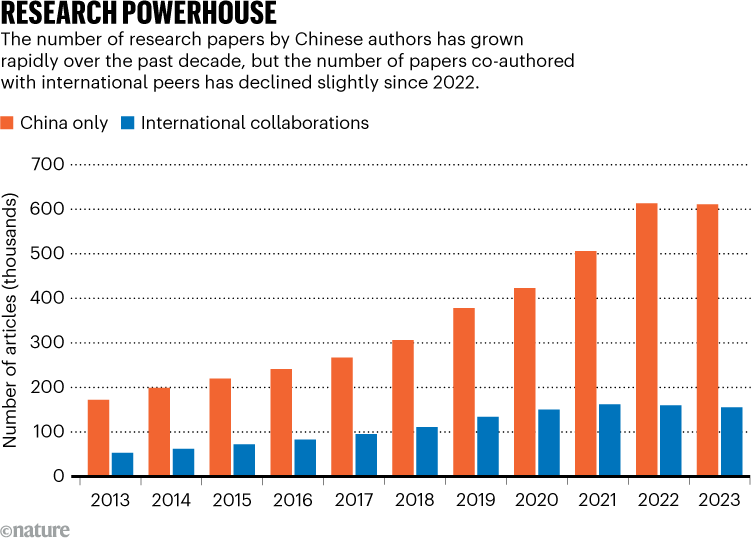
The proportion of research papers with Chinese and international co-authors has been falling for even longer. At its peak, in 2018, 26.6% — roughly 110,000 articles — of China’s output in the InCites database was co-authored with international colleagues. By 2023, the proportion of the country’s articles with international peers had dropped by 7.2%, despite China’s overall number of articles almost doubling to 759,000 over the same period.
The drop in internationally co-authored papers is mainly due to China’s declining share of papers published with US researchers, which fell by 6.4% between its peak in 2017 and 2023 — the largest decline of any country included in the analysis. The findings were presented at the Zhongguancun Forum in Beijing on 25 April.
The decline in US-China collaborations echoes findings from a 2022 analysis conducted for Nature , which found that the number of researchers with dual US and China affiliations on research articles in Elsevier’s Scopus database had fallen by more than 20% between 2019 and 2021.
Although the latest analysis shows that the share of US–China articles has been slowly declining over the past six years, the pandemic exacerbated the downward trend, says Marina Zhang, an innovation researcher who focuses on China at the University of Technology Sydney in Australia.
Political tensions
Zhang says that ongoing geopolitical tensions between the United States and China have also fuelled the decline. “This is especially worrying for researchers,” says Zhang. The US Department of Justice’s controversial China Initiative — which was launched in 2018 to tackle espionage in research and industry — ended in 2022. The crackdown resulted in several scientists being arrested over their ties to collaborators or institutions in China, and has stoked fear among researchers of Chinese descent. Since then, the US government has adopted a range of policies focused on tightening research security . And in July 2023, the Chinese government implemented its revised counter-espionage law, which broadened the definition of what constitutes spying.
The crackdown on perceived foreign interference in both the United States and China is making researchers more cautious about collaborating, says Zhang. Restrictive policies and the climate of fear could end up driving talent away from certain countries and fields, leading to a “brain drain and a loss of valuable human capital”, she says.
This “chilling effect” on US–China collaborations is already hindering influential research, says Tang Li, a researcher who specializes in science and innovation policy at Fudan University in Shanghai, China. For instance, a 2024 study examined the effect that the foreign-interference investigations at the US National Institutes of Health (NIH) had on researchers and found that those in the United States with collaborators in China were less productive during this period than were their colleagues with scientific partners in other countries 1 .
Zhang says that the faltering collaborative ties between the United States and China could also result in the countries pursuing the same types of research separately, instead of joining forces to tackle global problems such as climate change , pandemics and food security.
Turning inwards
More worryingly, the countries might increasingly prioritize domestic interests over international cooperation, which could make scientific research a more nationalistic endeavour, says Zhang.
China’s collaborations with other countries have also tapered off since 2020, but not as markedly as those with the United States. Tang says that reviving US–China collaborations is crucial because such scientific partnerships could help to bridge the gap between the two countries. “Given the increasing global disasters and uncertainties, humanity cannot afford to waste time on nationalistic rivalries,” she says.
doi: https://doi.org/10.1038/d41586-024-02046-9
Jia, R., Roberts, M. E., Wang, Y. & Yang, E. Proc. Natl Acad. Sci. USA 121 , e2301436121 (2024).
Article PubMed Google Scholar
Download references
Reprints and permissions
Related Articles

How US–China political tensions are affecting science
- Research data

So you got a null result. Will anyone publish it?
News Feature 24 JUL 24

Three-year delay for Indian census frustrates researchers
News 18 JUL 24

Estonians gave their DNA to science — now they’re learning their genetic secrets
News 26 JUN 24

Hijacked journals are still a threat — here’s what publishers can do about them
Nature Index 23 JUL 24

What is it like to attend a predatory conference?
Career Feature 18 JUL 24
Postdoctoral Associate- Neuroscience
Houston, Texas (US)
Baylor College of Medicine (BCM)
Chief Editor, Nature Materials
Job Title: Chief Editor, Nature Materials Location: New York, Shanghai or Beijing Closing date: Sept 2, 2024 Springer Nature, the publisher of N...
New York City, New York (US)
Springer Nature Ltd
Tenure Track Assistant or Associate Professor
Frontotemporal Dementia Research Center seeking highly motivated creative and collaborative scientist in RNA Biology to enhance our understanding.
Worcester, Massachusetts
UMass Chan Medical School
Department Head - Biomedical Engineering
VT BEAM seeks a Department Head to lead its innovative multidisciplinary approach bridging biomedical science with practical applications.
Blacksburg, Virginia
Virginia Tech- Biomedical Engineering
Postdoctoral Research Scientist
Postdoctoral Research Scientist in the Department of Pediatrics
Columbia University Irving Medical Center- Department of Pediatrics
Sign up for the Nature Briefing newsletter — what matters in science, free to your inbox daily.
Quick links
- Explore articles by subject
- Guide to authors
- Editorial policies
What causes lupus? A new study reveals potential treatment options.
The research found alternative pathways to regulating the abnormal autoimmune response.
A new study about the underlying mechanisms of lupus presents a novel way to potentially treat the autoimmune disease.
The study, led by researchers at Northwestern University and Brigham and Women’s Hospital, was published in Nature on Wednesday.
Get Well+Being tips straight to your inbox

The study’s findings raise a “compelling idea” for a novel way to treat lupus, said Deepak Rao , a rheumatologist at Brigham and Women’s Hospital, associate professor of medicine at Harvard Medical School and one of the senior authors of the study. But any potential treatment is still years away.
More than 200,000 people in the United States are estimated to have systemic lupus erythematosus (SLE) , the most common form of lupus and generally referred to as lupus, according to the Centers for Disease Control and Prevention.
- Lupus is a complex autoimmune disease in which the immune system turns on the body, producing antibodies that attack the skin, joints, kidneys, brain or other organs.
- In the study, the researchers compared the blood samples of people with lupus with a control group to measure the amount of certain white blood cells, T cells. Participants with lupus had higher levels of a specific T cell associated with the production of antibodies that can attack the body.
- The researchers worked backward, following the chain of events in the immune system, and identified insufficient activity of a receptor in the T cells, a protein called aryl hydrocarbon , as a potential root cause of the disease.
- Now, they’re studying whether a novel therapy could activate that receptor, leading the T cells to behave differently and, ultimately, through a cascade of events in the immune system, treat the autoimmune disease.
- The research was conducted in the lab and relied on blood samples from a small set of patients with lupus. Future studies will need to determine whether the findings are broadly applicable to others with the autoimmune disease.
“This doesn’t give us a cure for lupus tomorrow, but this helps us understand specific ways that we can disrupt the abnormal immune response,” Rao said. “We’re optimistic about this leading to a new set of therapies to inhibit autoimmune conditions like this.”
The study received grant funding from Merck Sharp & Dohme, a health-care company, and Janssen Research & Development. Some of the co-authors of the study were employees of AstraZeneca, a biopharmaceutical company, and Janssen while the study was conducted.
Rao said he has filed a patent application for a drug based on the results of the study with senior author Jaehyuk Choi , an associate professor of dermatology and biochemistry at Northwestern University Feinberg School of Medicine, and co-author Calvin Law , a graduate student at Northwestern University.
What other experts are saying
The hope for a cure is premature, but the study findings are “a promising pathway to look at and think about in terms of providing a more sophisticated way of treating lupus,” said Anca Askanase , a professor of medicine who is the director of the Columbia University Lupus Center and the director of rheumatology clinical trials at the university.
What causes lupus?
The four main types of lupus are SLE, neonatal and pediatric lupus erythematosus, discoid lupus erythematosus and drug-induced lupus.
Women , people of color and those with a family history of autoimmune disease are at a greater risk from autoimmune disorders, for reasons not clearly understood.
The cause of lupus is unknown, experts said, but “ genetic, hormonal, immunological, and environmental factors all play a role in the development of SLE,” according to a review.
“While lupus is not an immediately deadly disease like cancer, it robs people of a lot in their everyday lives and in years of life, as well,” Askanase said.
What are the symptoms associated with lupus?
Lupus can affect a number of organs, and symptoms can vary, experts said. People with SLE generally experience fever, fatigue and weight loss.
Pulmonary symptoms of lupus include shortness of breath, coughing and painful breathing, while gastrointestinal signs include nausea, vomiting and abdominal pain. Cardiovascular symptoms include coronary artery disease, pericarditis and myocarditis. Some patients suffer from anemia, leukopenia or thrombocytopenia. Kidney function can be affected in lupus, and about 50 percent of patients develop nephritis.
When lupus affects the joints, patients report pain, stiffness and inflammation. They are often diagnosed with arthritis, arthralgias or myalgias. And those with skin symptoms most commonly have a “butterfly” or red rash on the nose and cheeks after sun exposure. Other patients may suffer from alopecia , and mouth or nose sores.
Depression , anxiety and cognitive impairment are among the symptoms when lupus affects the central nervous system.
Is there a cure for lupus? How is it treated?
There is no cure for lupus, but treatments are “evolving quickly,” Karen Costenbader , a professor of medicine at Harvard Medical School and director of the Lupus Program at Brigham and Women’s Hospital, said in an email. Costenbader also was a researcher on the Nature study.
“In the past, medical providers treated the symptoms with steroids, which could have severe side effects, but there are several new and more targeted immunosuppressant medications that have become available and more are in development,” said Costenbader, who is also chair of the Lupus Foundation of America’s Medical-Scientific Advisory Council.
There are several medications to treat it, including hydroxychloroquine and other antimalarials. Many patients take a combination of drugs. These drugs can have side effects, some of which can be serious.
“Many therapies for lupus still are what we’d call broadly immunosuppressive,” Choi said. “If we could find molecular root causes of lupus, we could design potentially safer, more effective therapies.”
Diagnosis and treatment of lupus are challenging, experts said.
“You could have 300 patients in the same room, and they will have different clinical manifestations of lupus,” said Jill P. Buyon , director of the Division of Rheumatology and the Lupus Center at NYU Langone Health, who was not involved in the study.
It is hard to think of a “one size fits all” treatment, she said. The findings of this study are perhaps “taking us to precision medicine, where we could evaluate — exactly as Deepak Rao has done beautifully — let’s take our patients, let’s categorize them and those that fit into this paradigm, that’s the therapy we know to give them.”
“It’s a great paper. Incredibly well done,” Buyon said. “Is it the root cause? I don’t know if it’s the root cause. It might be a root cause.”
Are there any new lupus treatment options?
“There are newer biologic medications, such as belimumab, which targets the B lymphocyte stimulator, and anifrolumab, which blocks a protein called interferon that also signals to lymphocytes and stimulates them,” Costenbader said.
Several more potentially effective medications are in lupus clinical trials, she said. “Studies using chimeric antigen receptor (CAR) T lymphocytes raise hope that very effective inhibition of B cell responses may provide one path to a cure. The Nature study suggests a different but related strategy — altering the ability of T cells to stimulate abnormal B cell responses,” she said.
There has been “enormous progress” and the possibility of a cure because of investigators and “the extraordinary gift from people, volunteers that participate in observational research and clinical trials,” Askanase said.
What are the implications for other autoimmune diseases?
Several other autoimmune diseases such as Sjögren’s disease and rheumatoid arthritis have an excess of the T cells found in lupus patients, and the therapeutic treatment researchers proposed “could be beneficial across many of these diseases,” Rao said in an email.
Read more from Well+Being
Well+Being shares news and advice for living well every day. Sign up for our newsletter to get tips directly in your inbox.
A mystery illness stole their kids’ personalities. These moms fought for answers.
‘Menopause brain’ is real. Here’s how women’s brains change in midlife.
I’m an oncologist. Here’s what I advised my mom after her cancer diagnosis.
How to pick a retirement home and thrive
High levels of ultra-processed foods linked with early death , brain issues

Advertisement
Where Kamala Harris Stands on the Issues: Abortion, Immigration and More
She wants to protect the right to abortion nationally. Here’s what else to know about her positions.
- Share full article

By Maggie Astor
- Published July 21, 2024 Updated July 24, 2024, 9:09 a.m. ET
With Vice President Kamala Harris poised to replace President Biden on the Democratic ticket, her stances on key issues will be scrutinized by both parties and the nation’s voters.
She has a long record in politics: as district attorney of San Francisco, as attorney general of California, as a senator, as a presidential candidate and as vice president.
Here is an overview of where she stands.
Ms. Harris supports legislation that would protect the right to abortion nationally, as Roe v. Wade did before it was overturned in 2022, in Dobbs v. Jackson Women’s Health Organization.
After the Dobbs ruling, she became central to the Biden campaign’s efforts to keep the spotlight on abortion, given that Mr. Biden — with his personal discomfort with abortion and his support for restrictions earlier in his career — was a flawed messenger. In March, she made what was believed to be the first official visit to an abortion clinic by a president or vice president.
She consistently supported abortion rights during her time in the Senate, including cosponsoring legislation that would have banned common state-level restrictions, like requiring doctors to perform specific tests or have hospital admitting privileges in order to provide abortions.
As a presidential candidate in 2019, she argued that states with a history of restricting abortion rights in violation of Roe should be subject to what is known as pre-clearance for new abortion laws — those laws would have to be federally approved before they could take effect. That proposal is not viable now that the Supreme Court has overturned Roe.
We are having trouble retrieving the article content.
Please enable JavaScript in your browser settings.
Thank you for your patience while we verify access. If you are in Reader mode please exit and log into your Times account, or subscribe for all of The Times.
Thank you for your patience while we verify access.
Already a subscriber? Log in .
Want all of The Times? Subscribe .

IMAGES
VIDEO
COMMENTS
A research article usually has seven major sections: Title, Abstract, Introduction, Method, Results, Discussion, and References. The first thing you should do is to decide why you need to summarize the article. If the purpose of the summary is to take notes to later remind yourself about the article you may want to write a longer summary ...
Table of contents. When to write a summary. Step 1: Read the text. Step 2: Break the text down into sections. Step 3: Identify the key points in each section. Step 4: Write the summary. Step 5: Check the summary against the article. Other interesting articles. Frequently asked questions about summarizing.
The analysis shows that you can evaluate the evidence presented in the research and explain why the research could be important. Summary. The summary portion of the paper should be written with enough detail so that a reader would not have to look at the original research to understand all the main points. At the same time, the summary section ...
Write clearly and concisely, ensuring your summary accurately reflects the paper's content. 5. Writing the Introduction. After completing the summary, proceed to write the introduction. The introduction should provide an overview of the paper, a brief summary description, and state the main idea. 6.
The purpose of a research summary is to provide a brief overview of a research project or study, including its main points, findings, and conclusions. The summary allows readers to quickly understand the essential aspects of the research without having to read the entire article or study. Research summaries serve several purposes, including:
A summary should be written objectively and in a way that covers the article in sufficient detail—accurately yet briefly—to allow a reader to quickly absorb its significance. 3.1 Do some groundwork. Skim the article to get a rough idea of each section and the significance of the content. Read the paper in more depth.
One of the best ways to summarize and consolidate a research paper is to provide visuals like graphs, charts, pie diagrams, etc.. Visuals make getting across the facts, the past trends, and the probabilistic figures around a concept much more engaging. 5. Double check for plagiarism.
Understanding the Research Article. When you begin to summarize a research article, it's important to first understand the structure and content of the article. A research article usually consists of several sections including the title, abstract, introduction, methodology, results, discussion, and references.
When to write a summary. Step 1: Read the text. Step 2: Break the text down into sections. Step 3: Identify the key points in each section. Step 4: Write the summary. Step 5: Check the summary against the article. Frequently asked questions.
Summarize your thesis statement and the underlying meaning of the article. Adapted from "Guidelines for Using In-Text Citations in a Summary (or Research Paper)" by Christine Bauer-Ramazani, 2020. Additional Resources. All links open in a new window. How to Write a Summary - Guide & Examples (from Scribbr.com)
Here's how to do it successfully: Determine Your Focus: First, pinpoint why you're summarizing the article. If it's for personal study, you might opt for a detailed summary. For inclusion in a paper, concentrate on how the article's insights relate specifically to your work. Your purpose shapes your summary's focus.
Summarize long texts, documents, articles and papers in 1 click. Get the most important information quickly and easily with the AI summarizer. FAQ ... Ideal for academic research 🗎 Summarize any text: Articles, paragraphs & essays: Want to make sure your summary doesn't contain any plagiarism?
5. Scan the argument. Continue reading through the various segments of the journal article, highlighting main points discussed by the authors. Focus on key concepts and ideas that have been proposed, trying to connect them back to that main idea the authors have put forward in the beginning of the article.
Introduction. Writing a summary or abstract teaches you how to condense information and how to read an article more effectively and with better understanding. Research articles usually contain these parts: Title/Author Information, Abstract, Introduction, Methodology, Result or Findings, Discussion or Conclusion, and References.
Effective summarizing is necessary to both research and writing, because it can save a lot of time and paper, and it will allow you to review your research quickly. After reading articles during the research phase of your writing process, consider employing the following strategies: 1. Use summaries to communicate the main points of a text.
Eliminate words like "that," "in fact," "however," and adverbs. Make sure your summary is accurate. Then, use free websites like Hemingway App or paid services such as Grammarly to check for grammar or spelling issues. Watch For Plagiarism: Unless you're using a word coined by the researcher, paraphrase your text.
Scholarcy's AI summarization tool is designed to generate accurate, reliable article summaries. Our summarizer tool is trained to identify key terms, claims, and findings in academic papers. These insights are turned into digestible Summary Flashcards. Scroll in the box below to see the magic ⤸. The knowledge extraction and summarization ...
Try these steps for writing summaries: Select a short passage (about one to four sentences) that supports an idea in your paper. Read the passage carefully to fully understand it. Take notes about the main idea and supporting points you think you should include in your summary. Include keywords and terms used by the author and think, too, about ...
Step 3: Summarize each page, without plagiarism. Time to write summaries for each page or, if it makes sense, each core section. Page-level summaries ensure you don't forget anything relevant when writing a summary for the entire article. When I uploaded a research paper to Wordtune, I got 31 brief summaries.
A description of the sample, procedures, and measures. This section is very useful for fully understanding what the authors did, although you're unlikely to write much about it in your literature review. c. Results. An explanation of the statistics performed, and what the authors found. This section is important for learning the main findings ...
Skilled in market research and analysis, campaign optimization, and team leadership. Proven track record of driving revenue growth and increasing brand awareness." Why it works: This summary emphasizes the candidate's experience and leadership skills while also showcasing their ability to drive results through successful marketing campaigns ...
Welcome to Turnitin's new website for guidance! In 2024, we migrated our comprehensive library of guidance from https://help.turnitin.com to this site, guides.turnitin.com. During this process we have taken the opportunity to take a holistic look at our content and how we structure our guides.
Publishing a research elements article. These brief, peer-reviewed articles complement full research papers and are an easy way to receive proper credit and recognition for the work you have done. Research elements are research outputs that have come about as a result of following the research cycle - this includes things like data, methods ...
Summarizing a Research Article. Research articles use a standard format to clearly communicate information about an experiment. A research article usually has seven major sections: Title, Abstract, Introduction, Method, Results, Discussion, and References. Sometimes there are minor variations, such as a combined Results and Discussion section ...
Economic security programs: About 8 percent (or $545 billion) of the 2023 federal budget supported programs that provide aid (other than health insurance or Social Security benefits) to individuals and families facing hardship.Economic security programs include: the refundable portions of the Earned Income Tax Credit and Child Tax Credit, which assist low- and moderate-income working families ...
The research was funded by the Office of Naval Research, the National Institute of Mental Health, the National Institute of Neurological Disorders and Stroke, the National Science Foundation Directorate for Computer and Information Science and Engineering, the Simons Center for the Social Brain, the Simons Collaboration on the Global Brain, the ...
Two experimental tools that will speed fire detection and warning got a week-long test run in NOAA's new Fire Weather Testbed in June during a series of hands-on simulations with National Weather Service fire weather forecasters, state wildfire managers, researchers, and social scientists.. The first, NOAA's Next Generation Fire System, or NGFS, uses artificial intelligence to rapidly and ...
By 2023, the proportion of the country's articles with international peers had dropped by 7.2%, despite China's overall number of articles almost doubling to 759,000 over the same period.
The research was conducted in the lab and relied on blood samples from a small set of patients with lupus. Future studies will need to determine whether the findings are broadly applicable to ...
With Vice President Kamala Harris being eyed as a potential replacement for President Biden on the Democratic ticket, her stances on key issues will be scrutinized by both parties and the nation ...